United States Lines (USL) Archival Collection: Documents, Passenger Lists, Brochures, Menus & More

United States Lines operated cargo services from 1921 to 1989, and ocean liners until 1969—most famously, the SS United States and the Leviathan. The company was formed with three ships from the tonnage of the failed United States Mail Steamship Company. Two of the ships, the America and George Washington, were originally German vessels that had been seized during World War I and kept as reparations. One of the most famous ships, The 52,000 ton Leviathan, formerly the Vaterland and one of the largest liners in the world, was acquired in 1923. United States Lines absorbed the American Line in 1932, the Baltimore Mail Line in 1937, and the American Merchant Line in 1938.
Discover the United States Lines (USL) Archival Collection, featuring passenger lists, brochures, menus, immigrant documents, and historical narratives from 1921-1989. A resource for genealogists, historians, teachers, and maritime enthusiasts.
Introduction to the United States Lines (USL)
The United States Lines (USL) was a significant American shipping company that operated transatlantic ocean liners and cargo services from 1921 to 1989. Known for its iconic ships, such as the SS United States and the SS Leviathan, the company played a pivotal role in immigration, luxury travel, and maritime innovation. The USL Collection offers invaluable insights for genealogists, historians, educators, and maritime enthusiasts.
Collection Overview
The archival collection is categorized into several sections, each providing a glimpse into the daily life, travel experiences, and operational details of the United States Lines.
Key Highlights:
Passenger Lists: Immigration records and passenger manifests.
(1) America (2) George Washington (3) Leviathan (4) Manhattan
(5) President Arthur (6) President Garfield (7) President Harding
(8) President Monroe (9) President Roosevelt (10) President Van Buren
(11) Republic (12) United States (13) Washington
Brochures: Marketing materials that showcase the fleet's amenities.
Passage Contracts and Tickets: Historical travel documents.
Menus and Event Programs: Dining and entertainment experiences onboard.
Books and Articles: In-depth publications on the USL's operations and vessels.
Miscellaneous Ephemera: Letters, stationery, and historical artifacts.
1. Passenger Lists: Windows into Transatlantic Journeys
Passenger lists from the United States Lines serve as a genealogical goldmine, providing details such as passengers' names, origins, destinations, and ship details. These lists cover voyages from the 1920s to the 1950s.
Featured Passenger Lists:
- 1923-07-18: SS President Van Buren – New York to London
- 1925-08-05: SS America – Bremen to New York
- 1932-08-24: SS Manhattan – Hamburg to New York
- 1936-10-21: SS Manhattan – Hamburg to New York
- 1952-09-25: SS United States – Southampton to New York
Why It Matters: For genealogists and family researchers, these lists provide vital immigration and travel details that link ancestors to historical events.
::::: SS America Passenger Lists :::::
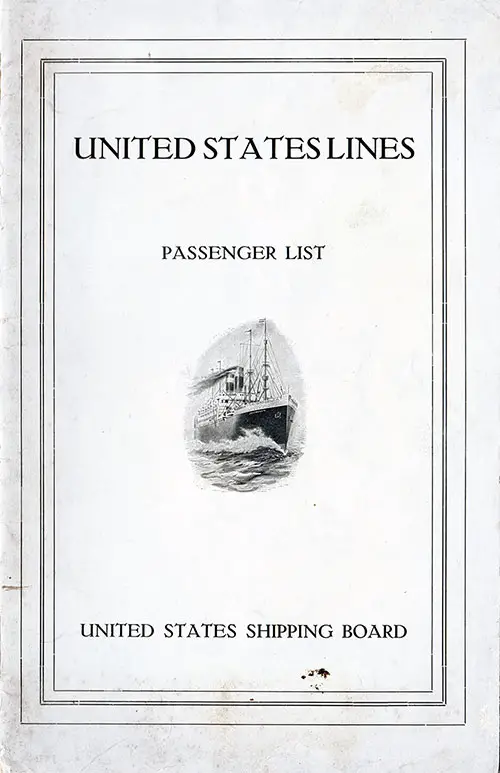
SS America Passenger List – July 12, 1922: Diplomats, Military Leaders & Influential Travelers
On July 12, 1922, the SS America of the United States Lines embarked on a transatlantic journey from Bremen to New York, making stops in Southampton and Cherbourg. Under the command of Captain W. Rind, U.S. Naval Reserve Force (USNRF), this voyage represented a significant chapter in post-World War I ocean travel, as European and American passengers sought economic opportunities, reunions with family, or simply a return to their homelands.
The voyage likely took around 10–12 days, depending on weather and sea conditions. As a cabin-class and second-class passenger ship, the SS America catered to upper-middle-class travelers, professionals, and immigrants moving between Europe and the United States.
Steamship Line: United States Lines
Class of Passengers: First and Second Cabin
Date of Departure: 12 July 1922
Route: Bremen to New York via Southampton and Cherbourg
Commander: Captain W. Rind
Notable Passengers: William Dawson Jr. (1885–1972), Agnes Chase (1869–1963), Colonel Victor E. Ruehl, Major Davenport Johnsen, Rev. J. A. Hennessy, Mr. Christian Hachmeister & Mrs. Christian Hachmeister, and Mrs. Mizzi Edle von Kragora.
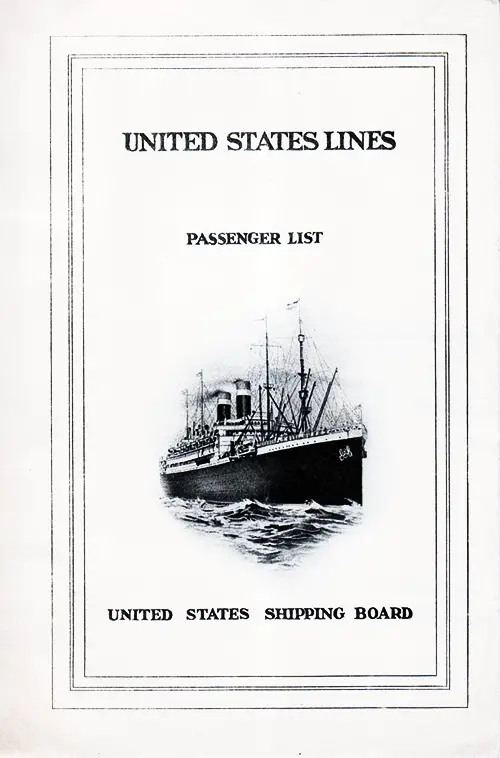
The SS America, operated by United States Lines, embarked on a transatlantic journey from Bremen, Germany, to New York City, with stops at Southampton (England) and Cherbourg (France). Departing on 22 February 1924, under the command of Captain W. Rind, U.S.N.R.F., the ship carried a mix of passengers, including diplomats, military personnel, scholars, clergy, business elites, and socialites.
The passenger list provides a fascinating snapshot of post-World War I transatlantic travel, showcasing individuals from diverse backgrounds. It also reflects the growing significance of United States Lines in the European-American passenger trade, particularly in transporting American citizens, returning expatriates, and European immigrants.
Steamship Line: United States Lines
Class of Passengers: Cabin
Date of Departure: 22 February 1924
Route: Bremen to New York via Southampton and Cherbourg
Commander: Captain W. Rind
Notable Passengers: Consul David Lewis, Captain William H. Reinburg, Comdg. J.W. Morse, Dr. Abraham Bernard, Dr. Martin Kerpel, Dr. Ladislaus H. Popper, Dr. Alfred Schröder, Rev. George B. Stone-Alcook, Sister Sophie Burmeister, Sister Caroline Strathmann, Martin Bekins & Mrs. Martin Bekins, James S. Gross & Mrs. James S. Gross, Miss Olive E. Blackhall & Mrs. Margaret B. Blackhall, Miss Isabelle Graves, Miss Irmgard von Bockum Dolffs, and Mrs. Martha de Grothy and Infant.
Récapitulation: 426 cabin passengers and 134 third-class passengers, total of 1,097 people, including crew members and postal clerks
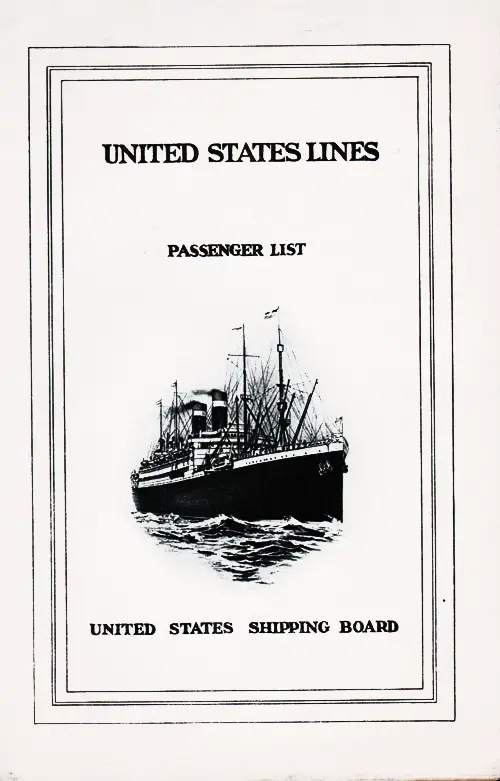
The SS America, a prominent passenger liner of the United States Lines, embarked on a transatlantic voyage on 27 July 1924, departing from Bremen, Germany, with stops at Southampton (England) and Cherbourg (France), before reaching New York City. Commanded by Captain W. Rind, U.S.N.R.F., the ship carried a remarkable mix of passengers, including Olympic athletes, high-ranking military officers, business leaders, academics, and prominent socialites.
The SS America’s voyage in July 1924 was one of international significance, carrying some of the most important figures of the era. From Olympic gold medalists to military officers, business leaders, and socialites, this crossing represents the global interconnectivity of sports, politics, business, and migration in the 1920s.
Steamship Line: United States Lines
Class of Passengers: Cabin
Date of Departure: 27 July 1924
Route: Bremen to New York via Southampton and Cherbourg
Commander: Captain W. Rind
Notable Passengers: Gertrude Ederle, Aileen Riggin, Helen Wainwright, Frederick "Fidel" La Barba, DeHart Hubbard, Robin Reed, Brigadier General Charles G. Treat, Colonel Robert M. Thompson, Lt. H. Liversedge, Capt. H. T. Allen & Capt. D. M. Scott, Hon. D. L. Conkling, Louis G. Dreyfus Jr., Edward B. Finch & Mrs. Finch, James C. Leavitt & Mrs. Leavitt, G. H. Bare & R. T. Breyer, Rev. D. W. Lenihan, Father Masterson, Sister Maria Samson, Mrs. Victor Blue, Mrs. Betty Dawes Hoyt & Miss Mary D. Hoyt, and Mrs. Tilda Strauss.
Récapitulation: 610 cabin passengers, 194 third-class passengers, 515 crew members, 1,322 Total souls on board

SS America: A Voyage of Diplomats, Socialites, and Intellectuals – 29 September 1924
The SS America, part of the United States Lines' prestigious fleet, set sail from Bremen, Germany, on 29 September 1924, making stops at Southampton (England), Cherbourg (France), and Queenstown (Cobh, Ireland), before reaching New York City. Commanded by Captain W. Rind, U.S.N.R.F., the ship carried a fascinating mix of high-ranking military officials, religious figures, business elites, artists, entertainers, and socialites, making this voyage a snapshot of 1920s global travel and influence.
With hundreds of cabin passengers, third-class travelers, and crew members, this voyage reflected the intersection of politics, business, culture, and migration in the post-World War I era.
This SS America journey captured the essence of the Roaring Twenties, a decade defined by economic prosperity, cultural exchange, and international diplomacy. With a remarkable blend of political leaders, military figures, socialites, artists, and religious figures, this voyage represents the diverse and evolving world of 1924 transatlantic travel.
Steamship Line: United States Lines
Class of Passengers: Cabin
Date of Departure: 29 September 1924
Route: Bremen to New York via Southampton, Cherbourg, and Queenstown (Cobh)
Commander: Captain W. Rind
Notable Passengers: E. R. Hardy Jr., Frank R. Van der Stucken, Col. C. E. Brigham, Louis Cohen & Thomas Coleman, Julius Leiter & Samuel Levy, Hon. P. W. A. Armbrister (Bahamas), Right Hon. Justice O’Shaughnessy (Ireland), Col. C. E. Brigham, Dr. Arthur E. Davis, Eric Ravndal, Rev. Francis Keenan, Rev. Robert Schwickerath, Mrs. Hilda Heywood & Miss Jennie Hedrick, Dorothy Grafly, Dr. George Pollack & Dr. Isaac Pollack, Walter Dewitt, Mrs. Florence Alexander & Miss Letitia Alexander, Mrs. Elizabeth Cumisky, and Mrs. Rachel Brown & Miss Betty Brown.

SS America: A Transatlantic Voyage of Diplomats, Military Leaders & Cultural Icons – August 5, 1925
The SS America, an esteemed vessel of the United States Lines, embarked on another remarkable transatlantic journey on August 5, 1925. Departing from Bremen, Germany, this grand liner made stops at Southampton (England) and Cherbourg (France) before concluding its voyage in New York City. Commanded by Captain W. Rind, U.S.N.R.F., and staffed by an elite team of officers, the voyage carried a fascinating blend of diplomats, military leaders, academics, socialites, and business magnates, offering a glimpse into the social fabric of the Roaring Twenties.
Steamship Line: United States Lines
Class of Passengers: Cabin
Date of Departure: 5 August 1925
Route: Bremen to New York via Southampton and Cherbourg
Commander: Captain W. Rind, U.S.N.R.F
Notable Passengers: Paul L. Baruch, Hon. Cyrenus Cole, Hon. Frederick Larrabee, Percival Hall Jr., Major A. L. Rockwood (U.S. Army), Capt. R. L. Coon, Dr. E. H. Reid, Judge Lawrence C. Fish, Judge C. J. Ten Eyck, Rev. J. W. Francis, Rev. R. O. Keen, Sister Mary Alberta & Sister M. Laurentia, Dorothy C. Wyman, Miss Janet Spitzer & Miss Mara Spitzer, and Miss Alice Godillot.
Récapitulation: 589 Cabin Passengers, 326 Third Class Passengers, 4 Sea Post Clerks, 530 Master and Crew, 1,449 Total Souls on Board
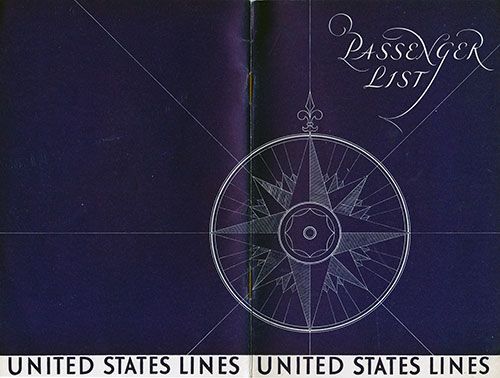
The SS America, a distinguished liner of the United States Lines, embarked on a remarkable transatlantic voyage on September 8, 1930. Departing from Hamburg, Germany, and stopping at Southampton (England), Cherbourg (France), and Cobh (Queenstown, Ireland) before arriving in New York City, the voyage represented the intertwining of diplomacy, culture, and global commerce during a pivotal time in world history. Among the passengeres were distinguished military leaders, academics, religious figures, and elite socialites, making this voyage a floating microcosm of the era's movers and shakers.
Steamship Line: United States Lines
Class of Passengers: Cabin
Date of Departure: 8 September 1930
Route: Hamburg to New York via Southampton and Cherbourg and Cobh (Queenstown)
Commander: Captain George Fried, U.S.N.R.
Notable Passengers: Hon. Thomas C. Cochran, Attorney General William D. Mitchell (U.S.), Major W. Bowie, Commander C. S. Gillette (U.S. Navy), Lt. Commander Robert H. Grayson (U.S. Navy), Captain Charles Ubel, Prof. H. M. Dadourian, Prof. A. E. Jenks (University of Minnesota), Bishop John Wells, Rev. Louis P. Remmele, Rev. Anthony Andruscavage, Father Peter O’Dwyer, Endicott Peabody, Miss Dorothy E. Lutin, and Miss Marion Bauer.
Récapitulation: 570 Cabin Passengers, 459 Tourist Class Passengers, 503 Commander, Officers, and Crew, 1,532 Total on Board.

SS America’s 1931 Voyage: Hope, Opportunity & Transatlantic Influence – July 28, 1931
In the midst of the Great Depression, transatlantic travel remained a gateway to new beginnings, intellectual exchange, and cultural connectivity. On July 28, 1931, the SS America, a prestigious ocean liner of the United States Lines, embarked on a momentous voyage from Hamburg, Germany, to New York, with stops at Southampton (England) and Cherbourg (France). Under the command of Captain A. M. Moore, U.S.N.R., the passenger list reflects a fascinating tapestry of notable religious leaders, intellectuals, and enterprising individuals, many seeking a fresh start in America or returning from influential travels abroad.
This voyage was not just about reaching a destination—it was about hope, ambition, and the promise of a better future in the midst of uncertain times.
Steamship Line: United States Lines
Class of Passengers: Tourist Third Cabin
Date of Departure: 28 July 1931
Route: Hamburg to New York via Southampton and Cherbourg
Commander: Captain A. M. Moore, U.S.N.R.

SS America’s 5 September 1947 Voyage: A Transatlantic Passage of Hope & Renewal
As the world transitioned from the aftermath of World War II into the early days of reconstruction and recovery, the SS America of the United States Lines embarked on a remarkable journey across the Atlantic. Departing from Southampton, England, on September 5, 1947, with stops at Cherbourg, France, and Cobh, Ireland, the ship carried a diverse group of passengers seeking new beginnings, reunions, and professional endeavors in the United States.
Under the esteemed leadership of Commodore Harry Manning, U.S.N.R., this voyage was more than just a transatlantic crossing—it was a symbol of resilience, opportunity, and post-war global unity. With a notable list of passengers, including religious figures, military personnel, intellectuals, and influential social figures, the ship reflected the era's social, political, and economic landscape.
Steamship Line: United States Lines
Class of Passengers: Tourist
Date of Departure: 5 September 1947
Route: Southampton to New York via Cherbourg and Cobh
Commander: Commodore Harry Manning
Notable Passengers: Rev. Bro. James, Rev. Bro. Malachy, and Rev. Bro. Patrick, Sister Mary Celsus, Sister Mary Alicia, Sister Mary Brigida, Sister Mary Gerard, Sister Mary Conleth, Sister Mary Agnes, Rev. Robert P. Mohan, Miss Francine Blumenfeld, Mr. Samuel N. Jackson, Miss Simone Weksler, Miss Jean M. Anthony & Miss K. Carey, Commodore Harry Manning, U.S.N.R. (Commander of the SS America), Executive Officer Leroy J. Alex Anderson, Commander, U.S.N.R., Chief Surgeon John Sheedy, Lieutenant, U.S.C.G., Mr. Samuel Lewin & Mrs. Loda Lewin, and Mr. Jacob Rupp & Mrs. Jacob Rupp.

The SS America, flagship of United States Lines, embarked on an illustrious voyage departing New York on 21 January 1948, bound for Southampton via Cobh (Ireland) and Cherbourg (France). This first-class passenger list not only provides insight into post-war transatlantic travel but also showcases a diverse roster of passengers, including military officials, aristocrats, entertainers, and influential professionals.
Commanded by Captain Harry Manning (U.S. Naval Reserve), a highly respected mariner, this voyage reflected the resurgence of ocean liner travel in the wake of World War II. Manning was renowned for his expertise in maritime operations and had played a role in Amelia Earhart's ill-fated 1937 flight, serving as her original navigator before stepping away from the mission.
Steamship Line: United States Lines
Class of Passengers: First Class
Date of Departure: 21 January 1948
Route: New York to Southampton via Cobh and Cherbourg
Commander: Captain Harry Manning, Captain, U.S.N.R.
Notable Passengers: Admiral Forrest Sherman (U.S. Navy, Chief of Naval Operations), Lt. Col. Howard S. Leach (U.S. Army), Count & Countess Dalle Rose and Countess C. Roussel De Courcy, Baroness M. Wodehouse Fox, Princess Helena Gourielli, Dr. Nathan Hollander, Jean Paul Drognon, Andre Simon, and Meer Fuchs & Laurent P. Goldberg.

The SS America, the pride of the United States Lines, set sail on February 20, 1948, departing Southampton, England, with stops at Cherbourg, France, and Cobh, Ireland, before making its way across the Atlantic to New York. Commanded by Captain Harry Manning, USNR, this voyage carried a fascinating mix of diplomats, military officers, academics, socialites, and business leaders, making it a compelling snapshot of post-World War II transatlantic travel.
This First-Class Passenger List is more than a simple record—it is a window into the past, capturing the individuals who played a role in politics, science, international relations, and commerce. The SS America, one of the finest passenger liners of its time, provided a luxurious experience for travelers moving between Europe and the United States at a time when commercial aviation had yet to dominate long-haul travel.
Steamship Line: United States Lines
Class of Passengers: First Class
Date of Departure: 20 February 1948
Route: Southampton to New York via Cherbourg and Cobh
Commander: Captain Harry Manning, Captain, U.S.N.R.
Notable Passengers: Col. Robert Emmens (U.S. Army Air Forces, Ret.), Col. Charles Miller (U.S. Army), Dr. Baruj Benacerraf, Prof. Konstantin Carsky, Dr. Jacques Codray, Henry R. Loomis, Norman Norell, Gustav F. Ahlbrandt, Countess Edith Gaines de Moltkhuitfeldt, Baronne Guy de Gunzburg, Consul Charles Stoppani, Rev. Mario Joseph Teilhard de Chardin, and Rev. W. J. Wallace.
::::: SS George Washington Passenger Lists :::::
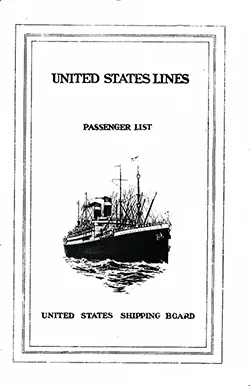
1924-08-22 SS George Washington Passenger List
Steamship Line: United States Lines
Class of Passengers: Cabin
Date of Departure: 22 August 1924
Route: Bremen to New York via Southampton and Cherbourg
Commander: Captain H. A. Cunningham, U.S.N.R.F
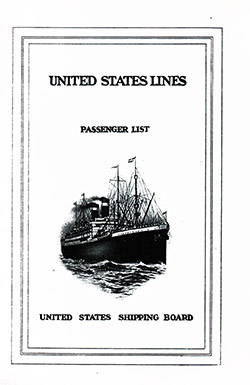
1924-09-19 SS George Washington Passenger List
Steamship Line: United States Lines
Class of Passengers: Cabin
Date of Departure: 19 September 1924
Route: Bremen to New York via Southampton and Cherbourg
Commander: Captain H. A. Cunningham

1925-09-23 SS George Washington Passenger List
Steamship Line: United States Lines
Class of Passengers: First and Second Class
Date of Departure: 23 September 1925
Route: Bremen to New York via Southampton and Cherbourg
Commander: Captain H. A. Cunningham, U.S.N.R.F

1928-05-19 SS George Washington Passenger List
Steamship Line: United States Lines
Class of Passengers: Tourist Third Cabin
Date of Departure: 19 May 1928
Route: New York to Bremen via Plymouth and Cherbourg
Commander: Captain A. B. Randall, U.S.N.R.

1928-06-06 SS George Washington Passenger List
Steamship Line: United States Lines
Class of Passengers: Tourist Third Cabin
Date of Departure: 6 June 1928
Route: Bremen to New York via Southampton and Cherbourg
Commander: Captain A. B. Randall, U.S.N.R.

1930-08-05 SS George Washington Passenger List
Steamship Line: United States Lines
Class of Passengers: Tourist Third Cabin
Date of Departure: 5 August 1930
Route: Hamburg to New York via Southampton, Cherbourg, and Cobh (Queenstown)
Commander: Captain A. B. Randall

1930-09-25 SS George Washington Passenger List
Steamship Line: United States Lines
Class of Passengers: Cabin Class
Date of Departure: 25 September 1930
Route: Hamburg to New York via Southampton and Cherbourg
Commander: Captain A. B. Randall, U.S.N.R.

1931-09-08 SS George Washington Passenger List
Steamship Line: United States Lines
Class of Passengers: Cabin Class
Date of Departure: 8 September 1931
Route: Hamburg to New York via Southampton and Cherbourg
Commander: Captain Geo. Fried, U.S.N.R.
::::: SS Leviathan Passenger Lists :::::

1924-08-05 SS Leviathan Passenger List
Steamship Line: United States Lines
Class of Passengers: First and Second Class
Date of Departure: 5 August 1924
Route: Southampton to New York via Cherbourg
Commander: Captain Herbert Hartley, U.S.N.R.F

1925-07-25 SS Leviathan Passenger List
Steamship Line: United States Lines
Class of Passengers: Tourist Cabin
Date of Departure: 25 July 1925
Route: New York to Southampton via Cherbourg
Commander: Captain Herbert Hartley, U.S.N.R.F

1925-08-25 SS Leviathan Passenger List
Steamship Line: United States Lines
Class of Passengers: First Class and Tourist Cabin
Date of Departure: 25 August 1925
Route: Southampton to New York via Cherbourg
Commander: Captain Herbert Hartley, U.S.N.R.F

1926-08-10 SS Leviathan Passenger List
Steamship Line: United States Lines
Class of Passengers: Cabin
Date of Departure: 10 August 1926
Route: Southampton to New York via Cherbourg
Commander: Captain Herbert Hartley, USNR

1926-09-21 SS Leviathan Passenger List
Steamship Line: United States Lines
Class of Passengers: First and Second Class
Date of Departure: 21 September 1926
Route: Southampton to New York via Cherbourg
Commander: Captain Herbert Hartley, U.S.N.R

1927-04-19 SS Leviathan Passenger List
Steamship Line: United States Lines
Class of Passengers: First and Second Class
Date of Departure: 19 April 1927
Route: Southampton to New York via Cherbourg
Commander: Commodore Herbert Hartley, U.S.N.R

1927-06-21 SS Leviathan Passenger List
Steamship Line: United States Lines
Class of Passengers: First and Second Class
Date of Departure: 21 June 1927
Route: Southampton to New York via Cherbourg
Commander: Commodore Herbert Hartley, U.S.N.R

1927-10-11 SS Leviathan Passenger List
Steamship Line: United States Lines
Class of Passengers: American Legion Passengers (Second A.E.F.)
Date of Departure: 11 October 1927
Route: Southampton to New York via Cherbourg
Commander: Commodore Herbert Hartley, U.S.N.R

1928-03-13 SS Leviathan Passenger List
Steamship Line: United States Lines
Class of Passengers: First and Second Class
Date of Departure: 13 March 1928
Route: Southampton to New York via Cherbourg
Commander: Captain H. A. Cunningham

1928-06-05 SS Leviathan Passenger List
Steamship Line: United States Lines
Class of Passengers: First and Second Class
Date of Departure: 5 June 1928
Route: Southampton to New York via Cherbourg
Commander: Captain A. H. Cunningham

1929-03-30 SS Leviathan Passenger List
Steamship Line: United States Lines
Class of Passengers: Cabin
Date of Departure: 30 March 1929
Route: Southampton to New York via Cherbourg
Commander: Commodore H. A. Cunningham

1929-08-27 SS Leviathan Passenger List
Steamship Line: United States Lines
Class of Passengers: Tourist Third Cabin
Date of Departure: 27 August 1929
Route: Southampton to New York via Cherbourg
Commander: Commodore H. A. Cunningham
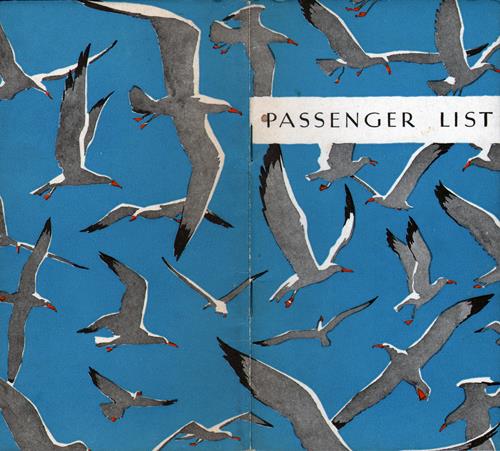
🛳️ SS Leviathan Passenger List – 9 September 1932: Transatlantic Travel During the Great Depression
Steamship Line: United States Lines
Class of Passengers: Tourist Cabin
Date of Departure: 9 September 1932
Route: Bremen to New York via Southampton and Cherbourg
Commander: Commodore Albert B. Randall, U.S.N.R
Step aboard the SS Leviathan in 1932—a majestic ocean liner operated by United States Lines, steaming from Bremen to New York via Southampton and Cherbourg at the height of the Great Depression. This rich Tourist Cabin Passenger List dated 9 September 1932, offers more than names—it’s a dynamic tapestry of global lives in motion, threading through academic, religious, artistic, and everyday histories.

1932-11-25 SS Leviathan Passenger List
Steamship Line: United States Lines
Class of Passengers: First Class and Tourist Cabin
Date of Departure: 25 November 1932
Route: Bremen to New York via Southampton and Cherbourg
Commander: Captain Commodore Albert B. Randall, U.S.N.R
::::: SS Manhattan Passenger Lists :::::

1932-08-24 SS Manhattan Passenger List
Steamship Line: United States Lines
Class of Passengers: Cabin Class
Date of Departure: 24 August 1932
Route: Hamburg to New York via Southampton and Le Havre and Queenstown (Cobh)
Commander: Captain George Fried

1932-10-19 SS Manhattan Passenger List
Steamship Line: United States Lines
Class of Passengers: Cabin Class
Date of Departure: 19 October 1932
Route: Hamburg to New York via Southampton and Le Havre and Queenstown (Cobh)
Commander: Captain George Fried

1934-07-18 SS Manhattan Passenger List
Steamship Line: United States Lines
Class of Passengers: Cabin Class
Date of Departure: 18 July 1934
Route: New York to Hamburg via Queenstown (Cobh), Plymouth and Le Havre
Commander: Captain Schuyler F. Cumings, Lt. Cmdr. USNR

1934-08-01 SS Manhattan Passenger List
Steamship Line: United States Lines
Class of Passengers: Cabin
Date of Departure: 1 August 1934
Route: Hamburg to New York via Le Havre, Southampton, and Cobh
Commander: Captain Schuyler F. Cumings

1934-10-24 SS Manhattan Passenger List
Steamship Line: United States Lines
Class of Passengers: Cabin Class
Date of Departure: 24 October 1934
Route: Hamburg to New York via Southampton and Le Havre and Queenstown (Cobh)
Commander: Commodore A. B. Randall, U.S.N.R.

1935-04-10 SS Manhattan Passenger List
Steamship Line: United States Lines
Class of Passengers: Cabin Class
Date of Departure: 10 April 1935
Route: Hamburg to New York via Southampton and Le Havre and Queenstown (Cobh)
Commander: Commodore A. B. Randall, U.S.N.R.

1935-07-31 SS Manhattan Passenger List
Steamship Line: United States Lines
Class of Passengers: Cabin Class
Date of Departure: 31 July 1935
Route: Hamburg to New York via Le Havre, Southampton, and Cobh
Commander: Captain Giles C. Stedman, Lt. Cmdr., USNR

1936-03-11 SS Manhattan Passenger List
Steamship Line: United States Lines
Class of Passengers: Cabin Class
Date of Departure: 11 March 1936
Route: Hamburg to New York via Le Havre, Southampton, and Cobh
Commander: Commodore A. B. Randall, U.S.N.R.

1936-07-29 SS Manhattan Passenger List
Steamship Line: United States Lines
Class of Passengers: Cabin Class
Date of Departure: 29 July 1936
Route: Hamburg to New York via Le Havre, Southampton, and Cobh
Commander: Captain Harry Manning, Lt., U.S.N.R.

1936-10-21 SS Manhattan Passenger List
Steamship Line: United States Lines
Class of Passengers: Third Class
Date of Departure: 21 October 1936
Route: Hamburg to New York via Le Havre, Southampton, and Cobh
Commander: Commodore A. B. Randall, Cmdr., U.S.N.R

1938-04-20 SS Manhattan Passenger List
Steamship Line: United States Lines
Class of Passengers: Cabin Class
Date of Departure: 20 April 1938
Route: New York to Hamburg via Cobh, Plymouth and Le Havre
Commander: Captain Albert B. Randall, U.S.N.R.
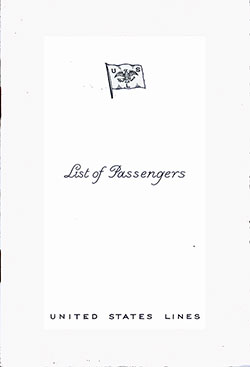
1938-06-29 SS Manhattan Passenger List
Steamship Line: United States Lines
Class of Passengers: Tourist Class
Date of Departure: 29 June 1938
Route: Hamburg to New York via Le Havre, Southampton and Cobh
Commander: Captain Albert B. Randall, U.S.N.R.

1939-03-10 SS Manhattan Passenger List
Steamship Line: United States Lines
Class of Passengers: Cabin
Date of Departure: 10 March 1939
Route: New York to Hamburg via Cobh, Plymouth, and Le Havre
Commander: Captain Albert B. Randall, CAPT. U.S.N.R.

1940-07-12 SS Manhattan Passenger List
Steamship Line: United States Lines
Class of Passengers: First Class
Date of Departure: 12 July 1940
Route: Lisbon to New York
Commander: Captain George V. Richardson, LCDR, USNR
Note: The SS Manhattan was transporting passengers fleeing Europe from Lisbon to New York City. These passengers capped a more or less continuous stream of Jewish migrants leaving various European countries after the Third Reich's rise to power in Germany.
::::: SS President Arthur Passenger Lists :::::

1923-10-19 SS President Arthur Passenger List
Steamship Line: United States Lines
Class of Passengers: Cabin
Date of Departure: 19 October 1923
Route: Bremen to New York via Southampton and Cherbourg
Commander: Captain P. H. Kreibohm, U.S.N.R.F
::::: SS President Garfield Passenger Lists :::::

1923-02-24 SS President Garfield Passenger List
Steamship Line: United States Lines
Class of Passengers: Cabin
Date of Departure: 24 February 1923
Route: London to New York via Cherbourg and Queenstown (Cobh)
Commander: Captain H. L. Look, U.S.N.R.F
::::: SS President Harding Passenger Lists :::::

1922-10-04 SS President Harding
Steamship Line: United States Lines
Class of Passengers: First Cabin
Date of Departure: 4 October 1922
Route: Bremen to New York via Southampton and Cherbourg
Commander: Captain Paul C. Grening

1923-01-06 SS President Harding Passenger List
Steamship Line: United States Lines
Class of Passengers: First Cabin
Date of Departure: 6 January 1923
Route: Bremen to New York via Southampton and Cherbourg
Commander: Captain P. C. Grening, U.S.N.R

1926-07-28 SS President Harding Passenger List
Steamship Line: United States Lines
Class of Passengers: Cabin
Date of Departure: 28 July 1926
Route: New York to Bremen via Cobh (Queenstown), Plymouth and Cherbourg
Commander: Captain Theodore Van Beek, U.S.N.R

1926-09-08 SS President Harding Passenger List
Steamship Line: United States Lines
Class of Passengers: Cabin
Date of Departure: 8 September 1926
Route: Bremen to New York via Southampton Cherbourg and Cobh (Queenstown)
Commander: Captain Theodore Van Beek, U.S.N.R.F

1927-03-16 SS President Harding Passenger List
Steamship Line: United States Lines
Class of Passengers: Cabin
Date of Departure: 16 March 1927
Route: Bremen to New York via Southampton and Cherbourg
Commander: Captain Theodore Van Beek, U.S.N.R

1928-07-18 SS President Harding Passenger List
Steamship Line: United States Lines
Class of Passengers: Cabin Class
Date of Departure: 18 July 1928
Route: Bremen to New York via Southampton and Cherbourg
Commander: Captain William Rind, USNR

1930-09-17 SS President Harding Passenger List
Steamship Line: United States Lines
Class of Passengers: Cabin Class
Date of Departure: 17 September 1930
Route: Hamburg to New York via Southampton and Cherbourg
Commander: Captain John L. Beebe, USNR

1937-09-01 SS President Harding Passenger List
Steamship Line: United States Lines
Class of Passengers: Cabin Class
Date of Departure: 1 September 1937
Route: Hamburg to New York via Le Havre, Southampton, and Queenstown (Cobh)
Commander: Captain James E. Roberts, Lt., Cmdr. U.S.N.R.

1938-09-14 SS President Harding Passenger List
Steamship Line: United States Lines
Class of Passengers: Cabin
Date of Departure: 14 September 1938
Route: Hamburg to New York via Le Havre, Southampton, and Cobh
Commander: Captain James E. Roberts (Lt. Cmdr. USNR)
::::: SS President Monroe Passenger Lists :::::

1922-08-02 SS President Monroe Passenger List
Steamship Line: United States Lines
Class of Passengers: Cabin
Date of Departure: 2 August 1922
Route: London to New York via Cherbourg
Commander: Captain M. L. Pittman, U.S.N.R.F
::::: SS President Roosevelt Passenger Lists :::::

1935-05-28 SS President Roosevelt Passenger List
Steamship Line: United States Lines
Class of Passengers: Cabin Class
Date of Departure: 28 May 1935
Route: Hamburg to New York via Le Havre, Southampton, and Cobh
Commander: Captain John F. Jensen, Lt. Cmdr., U.S.N.R.

1938-08-31 SS President Roosevelt Passenger List
Steamship Line: United States Lines
Class of Passengers: Cabin
Date of Departure: 31 August 1938
Route: Hamburg to New York via Havre, Southampton, and Cobh
Commander: Captain William Dougherty
::::: SS President Van Buren Passenger Lists :::::

1923-07-18 SS President Van Buren Passenger List
Steamship Line: United States Lines
Class of Passengers: Cabin
Date of Departure: 18 July 1923
Route: New York to London via Plymouth and Cherbourg
Commander: Captain A. M. Moore, U.S.N.R.F
::::: SS Republic Passenger Lists :::::

1926-09-24 SS Republic Passenger List
Steamship Line: United States Lines
Class of Passengers: Cabin
Date of Departure: 24 September 1926
Route: Bremen to New York via Southampton, Cherbourg, and Cobh (Queenstown)
Commander: Captain A. B. Randall, U.S.N.R.F
::::: SS United States Passenger Lists :::::

1952-09-25 SS United States Passenger List
Steamship Line: United States Lines
Class of Passengers: Tourist Class
Date of Departure: 25 September 1952
Route: Southampton to New York via Le Havre
Commander: Captain John W. Anderson, USNR.
::::: SS Washington Passenger Lists :::::

1933-05-24 SS Washington Passenger List
Steamship Line: United States Lines
Class of Passengers: Tourist Class
Date of Departure: 24 May 1933 (Maiden Voyage)
Route: Hamburg to New York via Le Havre, Southampton, and Queenstown (Cobh)
Commander: Captain George Fried, USN, Retired

1933-12-29 SS Washington Passenger List
Steamship Line: United States Lines
Class of Passengers: Tourist Class
Date of Departure: 29 December 1933
Route: Hamburg to New York via Le Havre, Southampton, and Queenstown (Cobh)
Commander: Captain John Jensen, USN, Retired

1934-05-23 SS Washington Passenger List
Steamship Line: United States Lines
Class of Passengers: Cabin
Date of Departure: 23 May 1934
Route: Hamburg on for New York via Havre, Southampton, and Cobh (Queenstown)
Commander: Captain George Fried, U.S.N. (Retired)

1934-08-15 SS Washington Passenger List
Steamship Line: United States Lines
Class of Passengers: Tourist Class
Date of Departure: 15 August 1934
Route: Hamburg to New York via Le Havre, Southampton, and Queenstown (Cobh)
Commander: Captain George Fried, USN, Retired.

1934-11-07 SS Washington Passenger List
Steamship Line: United States Lines
Class of Passengers: Cabin Class
Date of Departure: 7 November 1934
Route: Hamburg to New York via Le Havre, Southampton, and Queenstown (Cobh)
Commander: Captain Schuyler F. Cumings, Lt. Cmdr., USNR

1936-09-09 SS Washington Passenger List
Steamship Line: United States Lines
Class of Passengers: Tourist Class
Date of Departure: 9 September 1936
Route: Hamburg to New York via Le Havre, Southampton, and Queenstown (Cobh)
Commander: Captain Giles C. Stedman, Lt. Cmdr., U.S.N.R.

1938-04-20 SS Washington Passenger List
Steamship Line: United States Lines
Class of Passengers: Tourist Class
Date of Departure: 20 April 1938
Route: Hamburg to New York via Le Havre, Southampton, and Cobh
Commander: Captain Giles C. Stedman, Lt. Comm., U.S.N.R.

1938-09-30 SS Washington Tourist Class Passenger List
Steamship Line: United States Lines
Class of Passengers: Tourist Class
Date of Departure: 30 September 1938
Route: Le Havre to New York via Southampton and Cobh
Commander: Captain Giles C. Stedman, Lt. Comm., U.S.N.R.

1938-09-30 SS Washington Third Class Passenger List
Steamship Line: United States Lines
Class of Passengers: Third Class
Date of Departure: 30 September 1938
Route: Le Havre to New York via Southampton and Cobh
Commander: Captain Giles C. Stedman, Lt. Comm., U.S.N.R.

1939-08-22 SS Washington Passenger List
Steamship Line: United States Lines
Class of Passengers: Tourist
Date of Departure: 22 August 1939
Hamburg to New York via Le Havre, Southampton, and Cobh
Commander: Giles C. Stedman, LCDR, U.S.N.R

1951-01-10 SS Washington Passenger List
Steamship Line: United States Lines
Class of Passengers: Cabin Class
Date of Departure: 10 January 1951
Route: New York to Hamburg via Cobh, Southampton, Le Havre and Bremerhaven
Commander: Captain Harold Milde, U.S.N.R.
2. Passage Contracts and Tickets: A Glimpse into Immigrant Journeys
These documents provide insights into the personal and financial aspects of transatlantic travel. Contracts often include details on ticket classes, destinations, and associated costs.
Noteworthy Examples:
- 1921: SS Hudson – Contract manifest of Yugoslav immigrants.
- 1922: Prepaid Passage Receipt for Linda Strasszewska from Bremen to Chicago.
- 1923: SS Zeeland – Ticket for 13-year-old Polish immigrant Janina Kozlowski.
Why It Matters: These artifacts narrate the stories of thousands of immigrants seeking new lives in America.
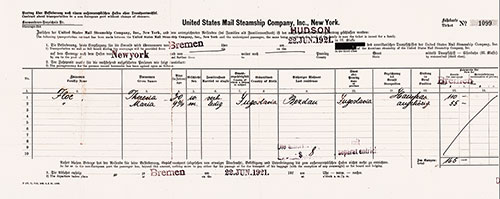
SS Hudson Passage Contract Manifest - 22 June 1921
This steerage passage contract manifest, dated 22 June 1921, represents a poignant chapter in post-World War I migration history. Issued by the United States Mail Steamship Company, Inc., the document chronicles the journey of Theresia Floc and her daughter Maria Floc, Yugoslavian nationals emigrating from Bremen to New York aboard the SS Hudson. The contract provides a comprehensive record of the voyage, ticket terms, and the challenges of immigrant travel during this pivotal era.
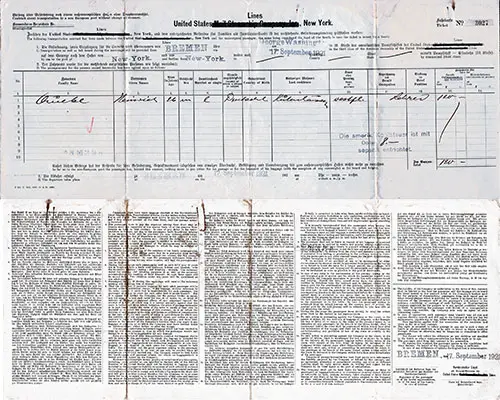
SS George Washington Passage Contract - 17 September 1921
An exceptionally rare artifact from the post-World War I migration era, this Third-Class/Steerage Passage Contract, issued by United States Lines on 17 September 1921, captures the poignant journey of a German immigrant aboard the illustrious SS George Washington. The contract not only represents the logistical and economic realities of steerage-class transatlantic travel but also underscores the personal stories of those seeking opportunity in the United States during a period marked by recovery and rebuilding.
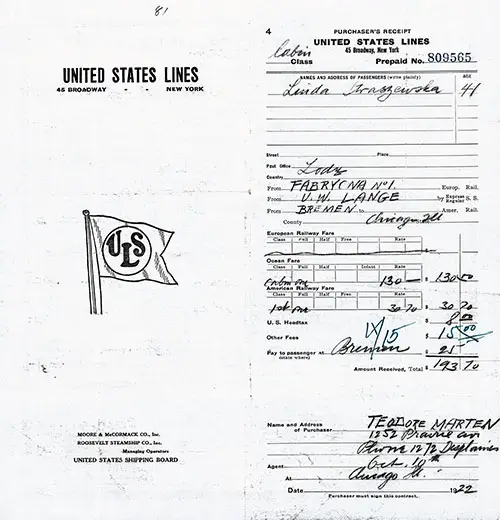
United States Lines Prepaid Passage Receipt - 10 October 1922
An extraordinary artifact of immigration history: a Prepaid Passage Receipt, issued by the United States Lines on 10 October 1922, for travel from Bremen to Chicago. This receipt, a testament to the aspirations of a Polish immigrant named Linda Strasszewska, encapsulates the complexity and logistical prowess of early 20th-century global migration. This document offered comprehensive travel arrangements, encompassing Cabin Class transatlantic passage and rail transportation from New York to Chicago, as well as auxiliary services such as a U.S. immigration head tax and provisions for incidental expenses.
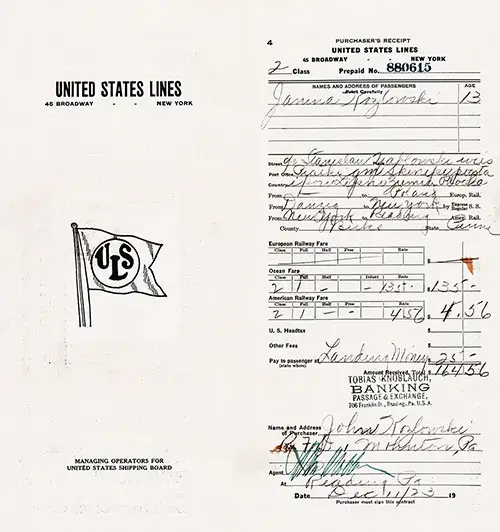
SS Zeeland Prepaid Purchaser's Receipt - 11 December 1923
An exceptional relic from the early 20th-century wave of European migration to America: a Second-Class Prepaid Purchaser’s Receipt for the SS Zeeland, issued on 11 December 1923. This receipt, connected to the passage of 13-year-old Polish immigrant Janina Kozlowski, symbolizes the enduring hopes and aspirations of countless families seeking a better life in the United States during a transformative period of global migration. This piece is particularly significant, as it represents the convergence of familial ties across continents, evidenced by the financial support of her sponsor, John Kozlowski, from Mohnton, Pennsylvania. The historical narrative encapsulated within this contract makes it a remarkable addition to any collection of immigration or maritime history.
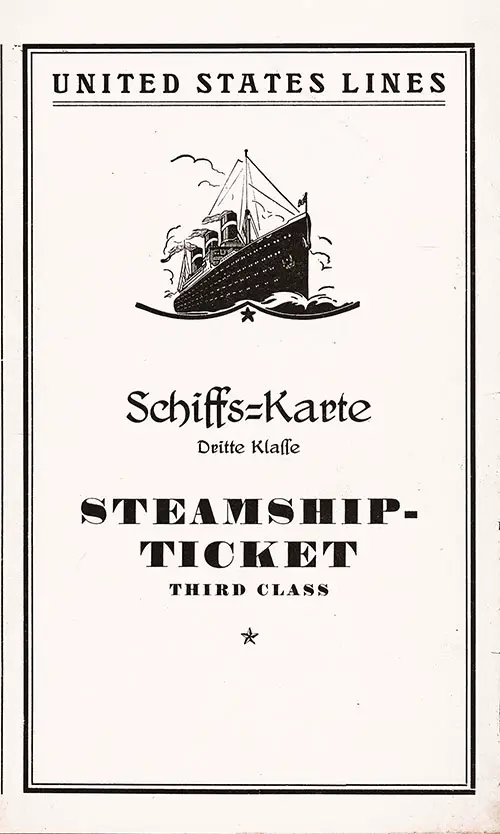
SS George Washington Passage Contract - 3 October 1928
An evocative relic of early 20th-century transatlantic migration, this Third-Class Passage Contract, issued by the United States Lines on 3 October 1928, exemplifies the practical and emotional aspects of immigrant travel during the interwar period. The artifact records the journey of a German national, Rudolph Arhlich, on board the iconic SS George Washington, sailing from Bremen to New York. Written in both German and English, this contract provides a comprehensive view of the terms and conditions under which third-class passengers traveled, including detailed regulations for baggage, provisions, and medical care.
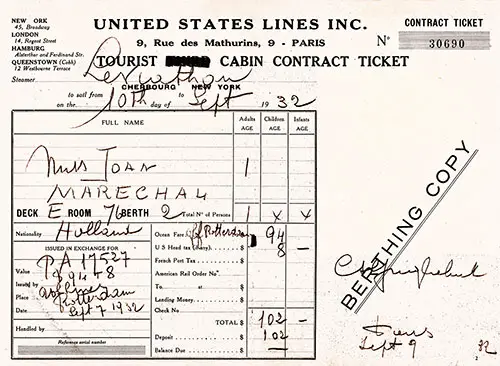
🛳️ Crossing the Atlantic in the Great Depression: 1932 SS Leviathan Tourist Cabin Passage Contract
The 1932 Tourist Cabin Contract Ticket for Miss Joan Marechal aboard the grand SS Leviathan is more than just a passage receipt—it’s a vivid snapshot of a world in flux, captured through the lens of a transatlantic voyage. This primary document, issued by United States Lines, illustrates not only the structure of interwar sea travel but also offers a compelling story of identity, resilience, and mobility during the Great Depression era.
3. Vintage Brochures: Marketing the Golden Age of Ocean Travel
The brochures reflect the evolving design, amenities, and marketing strategies of the United States Lines over decades.
Significant Brochures:
- 1922: Passenger Ships of the United States Lines – Early fleet details.
- 1923: SS Leviathan – Transition from wartime transport to luxury liner.
- 1924: The American Way to Europe – Guide for American tourists.
- 1938: Spring and Summer Travel Brochure – Focus on leisure travel post-Great Depression.
Why It Matters: These brochures reveal technological advancements and social dynamics of transatlantic travel.

Passenger Ships of the United States Lines (1922): Rebuilding America's Ocean Travel Legacy
The Passenger Ships of the United States Lines (1922) brochure provides a comprehensive look at the early years of U.S. government-owned ocean liners, detailing the emergence of a modern, efficient, and luxurious fleet of passenger ships operating under the United States Shipping Board Emergency Fleet Corporation (USSBEFC). This historically significant document outlines the rebirth of the American merchant fleet, following decades of decline after the Civil War, and its role in reestablishing American prominence on the seas.
This early promotional piece, filled with photographs and descriptions of shipboard amenities, is an invaluable resource for historians, educators, genealogists, and maritime enthusiasts, as it provides insight into 20th-century ocean travel, immigration trends, and the evolution of ship design and passenger experience.

SS Leviathan (1923) – The Greatest Luxury Liner of the United States Lines
The 1923 promotional brochure of the SS Leviathan is a visually rich and historically significant document that offers an in-depth look at the largest, most elegant, and most powerful steamship in the world at the time. Originally built as the German liner SS Vaterland, the ship was seized by the U.S. during World War I, repurposed as a troop transport, and later refitted into a flagship luxury liner for the United States Lines.
This comprehensive guide details Leviathan’s transformation from a wartime vessel to a floating palace, showcasing her unparalleled size, lavish interiors, and advanced engineering. The brochure’s large-format photographs and meticulous descriptions make it an invaluable resource for maritime historians, teachers, genealogists, and enthusiasts of ocean travel and ship design.

Third-Class Passage to Europe (1923) – The Evolution of Affordable Luxury Travel
The 1923 brochure on Third-Class Passage to Europe published by the United States Lines provides a remarkable and detailed insight into the often-overlooked third-class travel experience during the golden age of transatlantic steamship voyages. This document not only illustrates the improvements in third-class accommodations but also challenges the stereotypes of steerage travel with descriptions of clean, comfortable, and well-appointed living and recreational spaces.
For teachers, students, genealogists, and maritime historians, this brochure is a treasure trove of information about early 20th-century ocean travel, societal structures, and the experience of working- and middle-class passengers who crossed the Atlantic.

Across the Atlantic in Style: The 1924 United States Lines Brochure Unveiled
The 1924 brochure from the United States Lines provides a rich glimpse into transatlantic ocean travel during the early 20th century. With routes connecting New York to Plymouth, Cherbourg, Southampton, and Bremen, the brochure showcases a fleet of elegant, American-operated steamships. This resource holds significant value for teachers, students, genealogists, and maritime historians interested in understanding ocean travel's social, economic, and technical aspects during this period.
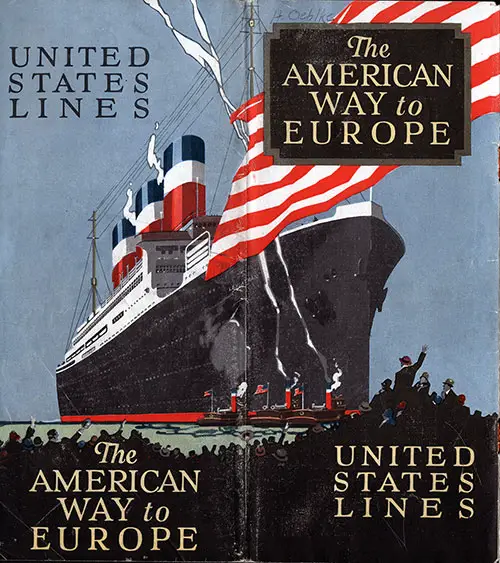
1924 Brochure - United States Lines - The American Way to Europe
The 1924 United States Lines brochure, The American Way to Europe, serves as a captivating historical artifact that provides a detailed look at transatlantic ocean travel during the early 20th century. This meticulously crafted publication does more than list ships and schedules—it transports readers into the vibrant world of ocean liners, illustrating the luxurious, comfortable, and practical aspects of maritime journeys to Europe. For teachers, students, genealogists, and maritime historians, this brochure is a rich educational resource that brings to life the social customs, travel standards, and technological advancements of the time.
The brochure showcases the fleet of the United States Lines, including the iconic SS Leviathan, SS George Washington, SS America, SS Republic, SS President Harding, and SS President Roosevelt. Through vivid descriptions, photographs, and anecdotes, readers gain insights into the various travel classes—First Class, Cabin Class, Second Class, and Tourist Third Cabin—highlighting the differences in accommodations, amenities, and social atmospheres aboard these vessels.

The 1936 informational brochure for the SS Manhattan and SS Washington offers a detailed glimpse into transatlantic ocean travel aboard two of America's fastest liners of the era. This historical document serves as an invaluable resource for educators, students, genealogists, and maritime historians, presenting a rich tapestry of social customs, maritime operations, and onboard experiences of the 1930s.
The 1936 brochure for the SS Manhattan and SS Washington is more than a historical artifact; it's a window into the transatlantic travel experience of the 1930s. Its detailed accounts of passenger amenities, social customs, and travel regulations make it an invaluable resource for understanding ocean travel's broader historical context. For those passionate about maritime history, this document captures the elegance, innovation, and complexities of a bygone era, offering enduring relevance for modern audiences interested in the golden age of ocean liners.

The United States Lines Spring & Summer Travel 1938 brochure provides an engaging look into the golden age of transatlantic travel. With vivid photography and detailed descriptions, it offers insights into the luxurious and practical aspects of life aboard the SS Manhattan and SS Washington. This piece serves as a valuable resource for teachers, students, genealogists, historians, and anyone fascinated by the evolution of ocean travel.
This 1938 brochure is more than just a travel guide; it's a historical document. For genealogists, it provides context around the travel experiences of ancestors who may have crossed the Atlantic on these vessels. For educators and students, it serves as a vivid snapshot of pre-WWII maritime culture. The descriptions of staff roles, passenger activities, and travel logistics illuminate how travel transformed into a more accessible and enjoyable endeavor for everyday Americans.

Affordable Ocean Luxury: The 1939 United States Lines Experience
The 1939 brochure Travel in Luxury at Low Cost from the United States Lines presents an engaging and informative look into transatlantic travel options just before World War II. With vivid descriptions, captivating photographs, and practical insights, the brochure paints a picture of comfortable, affordable ocean voyages for a diverse range of passengers. This historical document holds significant value for teachers, students, genealogists, historians, and others interested in maritime travel, 20th-century tourism, and social history.
This brochure is more than a promotional piece for ocean travel; it reflects the era's travel trends, economic considerations, and the leisure habits of pre-war America and Europe. Teachers can use it to illustrate the importance of ocean liners in international travel before the rise of commercial aviation. Historians might find the documented fares, schedules, and social dynamics aboard these liners useful for understanding interwar travel culture. Genealogists may also glean insights into the voyages their ancestors undertook when immigrating or traveling abroad.
4. Menus and Musical Programs: Life Aboard the Liners
Dining aboard USL vessels was an event in itself. The menus detail culinary offerings, while musical programs provide insight into onboard entertainment.
Memorable Menus:
- 1922-08-10: SS President Monroe – Captain's Farewell Dinner.
- 1926-09-26: SS Leviathan – Elegant multi-course farewell dinner.
- 1934-07-24: SS Manhattan – Gourmet dining with live music.
- 1954-08-10: SS America – Captain's Dinner with guest autographs.
Why It Matters: Historians and culinary enthusiasts can explore changing tastes and dining customs at sea.
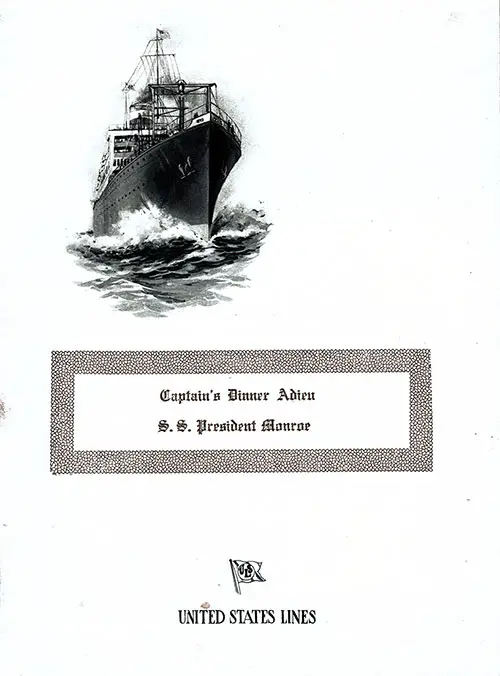
A Culinary Voyage at Sea: SS President Monroe's 1922 Captain's Farewell Dinner Menu
The Captain's Farewell Dinner aboard the SS President Monroe on August 10, 1922, presents an intriguing snapshot of early 20th-century maritime dining. This menu, reflecting both American and European culinary influences, showcases a diverse selection of dishes meant to leave passengers with a memorable dining experience before disembarking. The array of offerings speaks to the luxury and sophistication of transatlantic travel during the era.
From a culinary reviewer's perspective, this menu offers variety across multiple courses and demonstrates a thoughtful approach to international and traditional American fare. Passengers aboard this voyage enjoyed a delightful mixture of rich, comforting dishes and refined European specialties, some of which might have been unfamiliar to the typical American traveler of the 1920s.
This menu offers more than a list of dishes; it is a portal into a bygone era when ocean travel was synonymous with elegance, discovery, and culinary adventure.
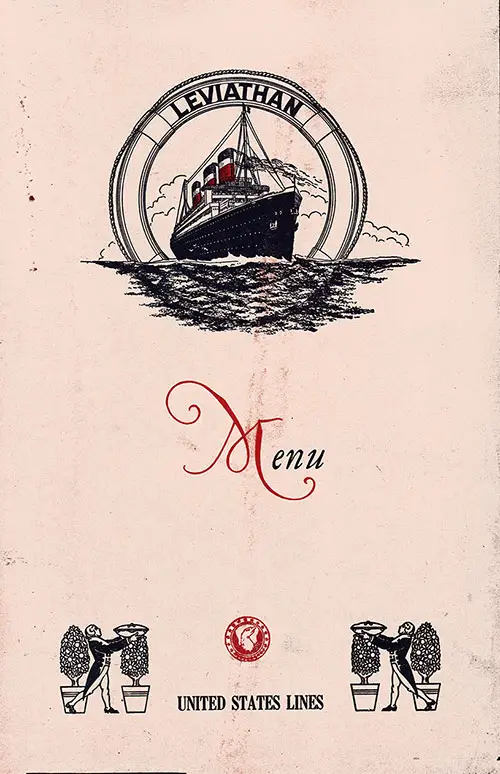
A Grand Culinary Voyage: Exploring the 1926 SS Leviathan Farewell Dinner Menu
The SS Leviathan, an icon of 1920s transatlantic luxury, presented its passengers with a grand culinary experience during the farewell dinner on 26 September 1926. The menu is more than a list of dishes; it reflects the era's social customs, culinary preferences, and ocean liner traditions. For teachers, students, genealogists, and historians, this menu offers insights into passenger life, cultural influences on cuisine, and the sophistication of ocean travel in the early 20th century.
The SS Leviathan’s farewell dinner menu is a testament to the era's culinary sophistication and the ship's role in offering passengers more than transportation—it delivered an immersive cultural and sensory experience. From elegant appetizers to indulgent desserts, the meal reflects the vibrancy and international influence of ocean travel during the Roaring Twenties.
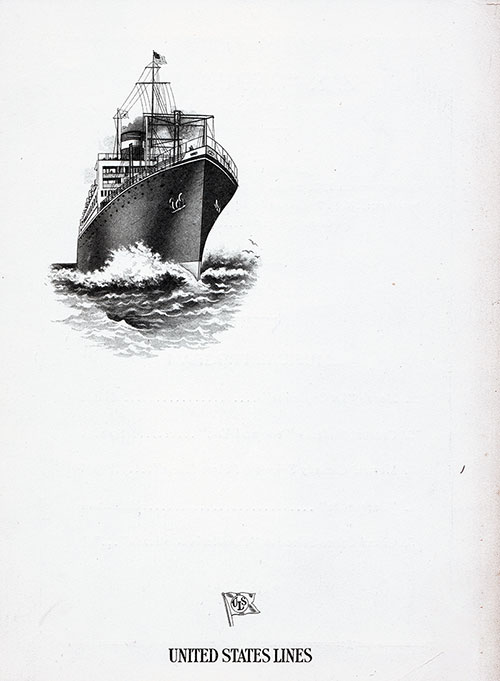
Culinary Elegance at Sea: A Review of the SS Republic 1926 Captain's Farewell Dinner
The Captain's Farewell Dinner aboard the SS Republic on October 3, 1926, presented passengers with an elegant culinary experience, showcasing the refinement and sophistication characteristic of transatlantic ocean liners during this era. The menu was a symphony of international flavors, blending American favorites with European delicacies.
The SS Republic's 1926 Captain's Farewell Dinner menu was a blend of traditional American favorites and adventurous European dishes. It provided passengers with a gastronomic tour of the Old and New Worlds, likely leaving many diners with fond culinary memories of their transatlantic crossing.
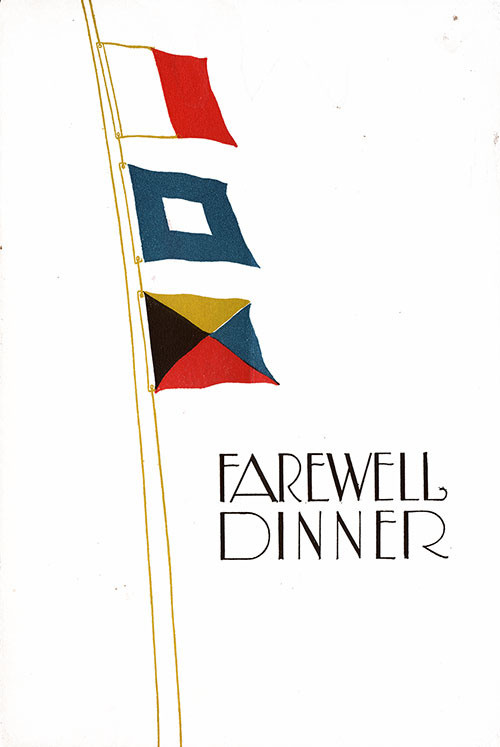
Gourmet Elegance at Sea: A Culinary Journey on the SS Leviathan, May 1928
The SS Leviathan, flagship of the United States Lines, epitomized the height of ocean travel luxury. The Farewell Dinner held on May 10, 1928, was not just a meal but a grand culinary event. Passengers were treated to a diverse selection of gourmet dishes that reflected the international flair and sophisticated tastes of the time. From exotic game meats to timeless seafood classics, the menu combined traditional American favorites with European culinary techniques, offering a rich tapestry of flavors that left an indelible impression.
The SS Leviathan's menu showcased a fascinating blend of seafood, game, and classic European techniques. Diners could choose from multiple soup options, including Consommé Double served hot or cold—an innovative feature at the time. The array of vegetables, from buttered beets to creamed parsnips, ensured passengers had familiar and comforting choices alongside more adventurous fare.
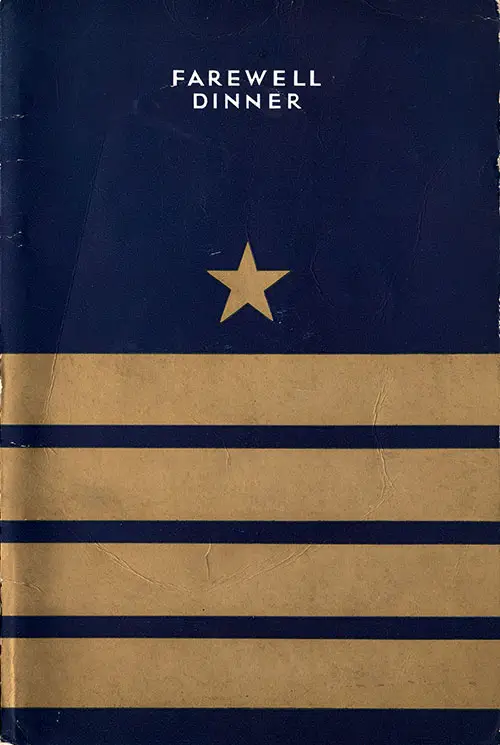
A Culinary Farewell at Sea: Exploring the 1931 SS George Washington Farewell Dinner Menu
The farewell dinner aboard the SS George Washington on July 7, 1931, was more than just a meal; it was a carefully curated culinary experience that reflected the opulence and sophistication of transatlantic ocean travel during the interwar period. With a diverse menu featuring both classic American and exotic European dishes, passengers were treated to a memorable evening that likely became a highlight of their journey.
The dinner was accompanied by a musical program, fostering an atmosphere of camaraderie and celebration as passengers approached their destination. Led by Captain George Fried, the voyage offered guests a final taste of luxury before disembarking, leaving them with delicious memories to share upon their return home.
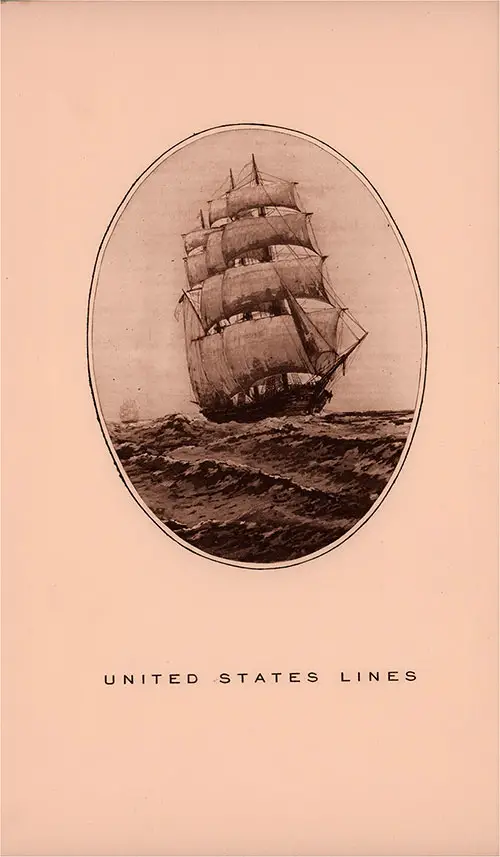
A Gourmet Voyage: The SS Washington Farewell Dinner Menu of 1933
The SS Washington’s Farewell Dinner Menu from November 26, 1933, presents a captivating culinary experience that encapsulates the luxury of transatlantic travel. This tourist cabin menu showcases a diverse array of dishes, from rich hors d'oeuvres to decadent desserts, providing passengers with a memorable farewell meal. The extensive selection not only caters to varying tastes but also offers insights into the gastronomic preferences of ocean travelers during the early 20th century.
The 1933 SS Washington Farewell Dinner Menu exemplifies the elegance and diversity of ocean liner cuisine in the interwar years. Its mixture of familiar and exotic offerings ensured a memorable dining experience, particularly for passengers new to European culinary traditions. The inclusion of dishes like reindeer noisette, green turtle soup, and eggs à la Volga, along with luxurious seafood options, highlighted the menu’s international flair. For genealogists, historians, and culinary enthusiasts, this menu serves as a delicious snapshot of transatlantic life, blending American tastes with European sophistication on the high seas.
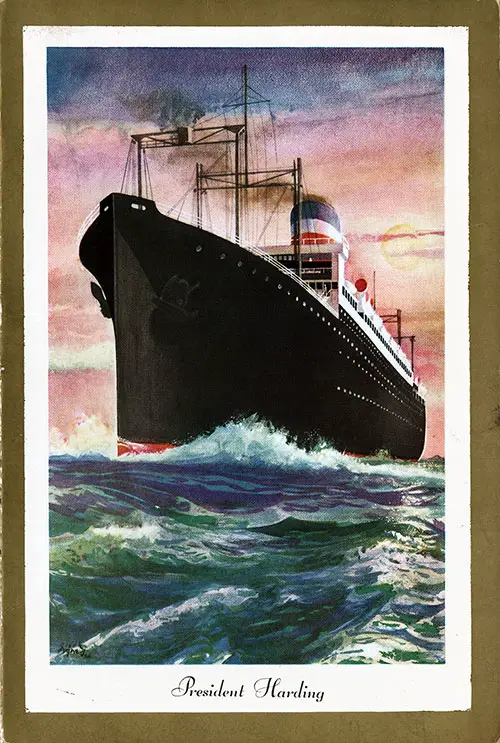
1934-04-12 SS President Harding Farewell Dinner Menu
The SS President Harding's Farewell Dinner Menu from April 12, 1934, offers a delightful snapshot of transatlantic dining aboard a United States Lines vessel. This third-class menu reflects the culinary variety, quality, and creativity characteristic of ocean travel during the interwar period. From familiar favorites to more exotic selections, the menu provides insight into the social and culinary experiences shared by passengers of various backgrounds.
The SS President Harding's Farewell Dinner Menu from April 1934 exemplified the thoughtful planning behind even third-class meals on ocean liners of the era. The variety of dishes, inclusion of luxurious elements like caviar, and presence of European culinary influences made this meal a memorable part of the transatlantic journey. For teachers, students, genealogists, and history enthusiasts, this menu offers more than a list of foods; it provides a flavorful glimpse into the social and culinary dynamics of maritime travel in the 1930s.
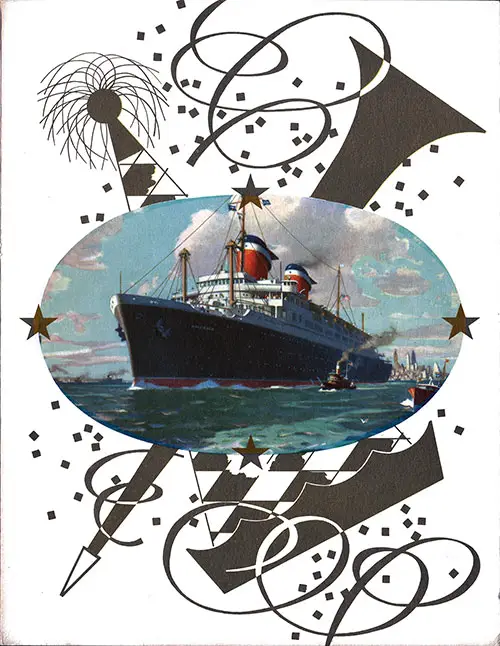
The Captain's Dinner aboard the SS America on August 10, 1954, was a celebration of culinary artistry and maritime tradition. This grand occasion featured a diverse selection of dishes, from elegant appetizers to rich desserts, accompanied by the nostalgic ambiance of ocean travel under the Stars and Stripes. The menu showcases the sophistication and variety of meals served during mid-century transatlantic crossings, offering modern historians, genealogists, educators, and culinary enthusiasts a savory slice of ocean liner heritage.
The SS America’s Captain's Dinner on August 10, 1954, exemplifies the golden age of ocean liner dining with its extensive variety, international influences, and luxurious presentation. The highlighted entrees of Lobster à la Newburg and Grilled T-Bone Steak would have appealed to passengers seeking either continental sophistication or hearty, familiar fare. The inclusion of unique items like Green Turtle Soup and Champagne Sherbet underscores the menu’s historical value as a snapshot of post-war leisure travel.

A Gourmet Easter Celebration at Sea: SS Manhattan's 1935 Easter Dinner Menu
The SS Manhattan's Easter Dinner Menu from 21 April 1935 reflects the elegance and culinary variety typical of luxury ocean liner travel during the early 20th century. The meal was a carefully orchestrated affair featuring a wide selection of soups, entrées, roasts, desserts, and even a musical program. The extensive menu demonstrated the chef’s dedication to quality, seasonal ingredients, and international flair.
The SS Manhattan's 1935 Easter Dinner was more than just a meal; it was a culinary journey showcasing international flavors, seasonal ingredients, and a festive atmosphere. From the indulgent Boiled River Salmon to the comforting Roast Vermont Turkey, the menu offered passengers a taste of luxury during their ocean crossing. For teachers, students, genealogists, and culinary historians, this menu serves as a rich resource for understanding mid-20th-century dining culture aboard luxury liners.
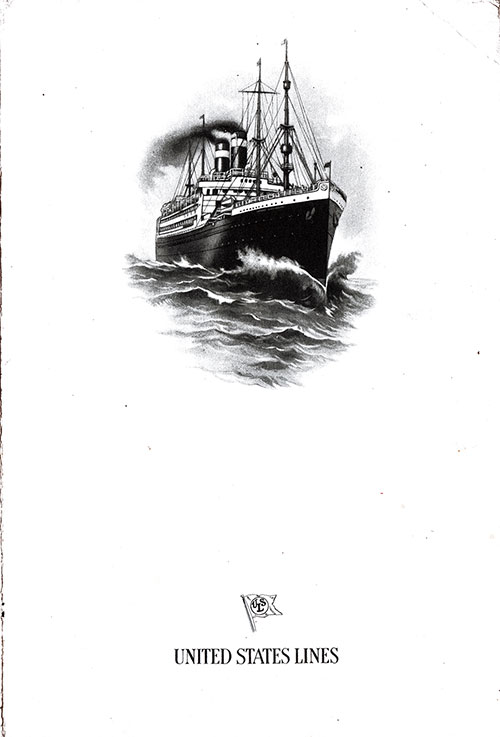
A Taste of Transatlantic Elegance: SS President Arthur’s Dinner Menu of 19 October 1923
The SS President Arthur's dinner menu from 19 October 1923 presents a fascinating glimpse into the dining experience aboard early 20th-century transatlantic voyages. The variety of dishes reflects a blend of American and European culinary traditions, crafted to cater to a diverse passenger list. This menu, offered in both English and German, showcases the sophistication and international appeal of ocean liner dining during this era.
The bilingual nature of the menu indicates a passenger base that included both American and German-speaking travelers. The concert program accompanying the meal added an element of sophisticated entertainment, making the dining experience more than just a meal—it was an event.
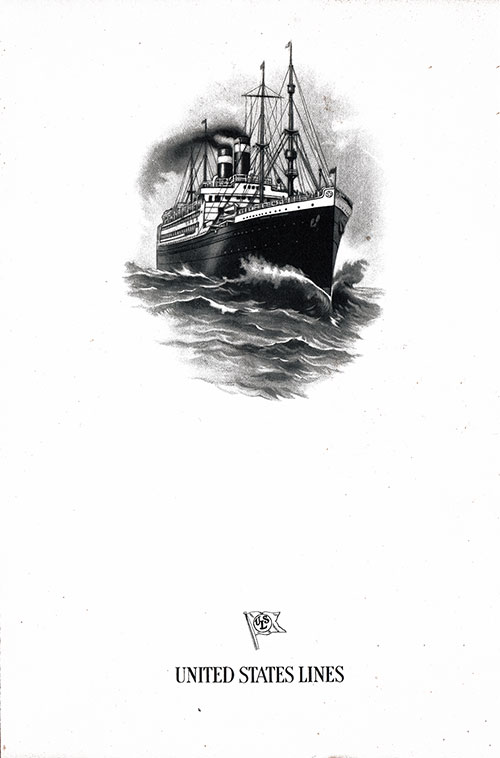
Savoring Elegance at Sea: A Culinary Journey Aboard the SS President Arthur - October 21, 1923
The SS President Arthur's dinner menu from October 21, 1923, offers a fascinating glimpse into the culinary landscape aboard a transatlantic voyage in the early 20th century. With a selection of soups, fish, entrées, roasts, vegetables, and desserts, this menu reflects both international influences and American comfort foods, designed to cater to a diverse passenger base.
The selection of dishes indicates a balance between continental European influences and American favorites. The inclusion of German text alongside the English menu reflects the era's significant German-American passenger demographic. Classic French sauces (Colbert, Hollandaise) and dishes (Calf's Head en Tortue) showcase the influence of French haute cuisine on the menu.
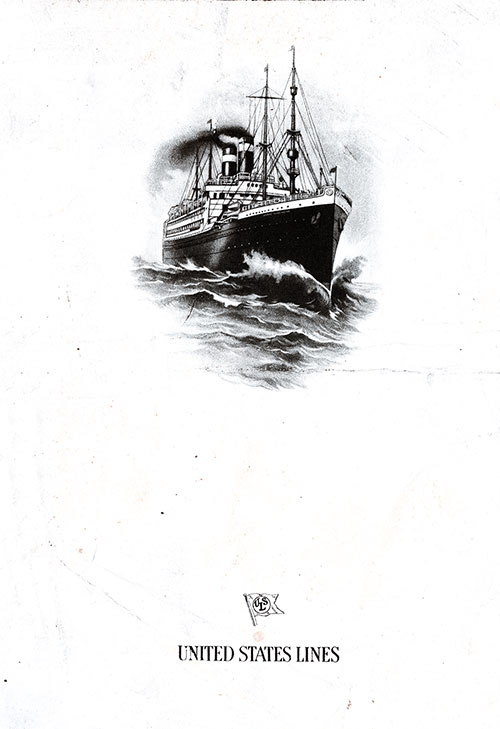
The dinner menu from the SS President Arthur, dated October 22, 1923, offers a captivating snapshot of early 20th-century ocean travel dining. This meal was more than sustenance; it was an experience—a testament to the luxury and attention to detail that defined United States Lines voyages. The menu, printed in both English and German, ensured accessibility for international travelers and showcased a diverse, elaborate array of offerings across multiple courses.
The SS President Arthur's October 22, 1923, dinner menu serves as a flavorful time capsule, blending culinary creativity with classic comfort. For passengers, this meal was more than a dinner—it was an event that reflected the era's sophistication in ocean travel. From adventurous items like Fried Lamb Tongue to the universally pleasing Patties à la Reine, the menu offers a window into the tastes and trends of transatlantic voyaging nearly a century ago.
The inclusion of a concert program alongside the dinner selections added to the ambiance, underscoring the ship's commitment to an elegant and immersive dining event.
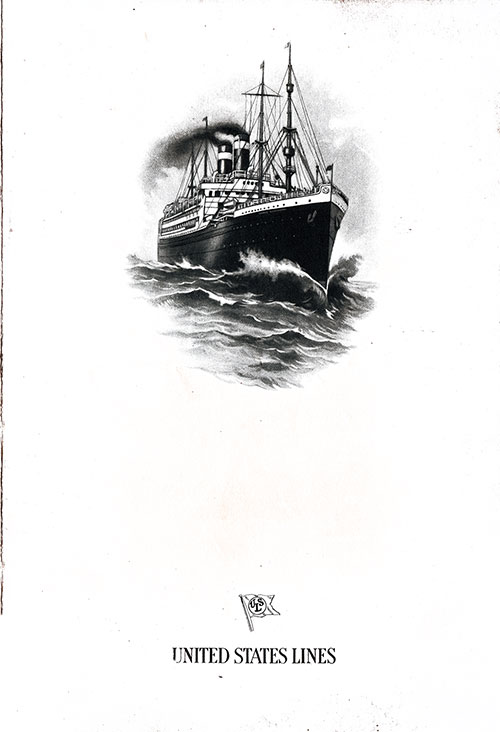
A Culinary Voyage: SS President Arthur's Dinner Menu - 23 October 1923
The SS President Arthur's dinner menu from October 23, 1923, provides a remarkable glimpse into the culinary experience aboard United States Lines during the early 20th century. This well-rounded menu offers a variety of dishes catering to diverse palates while showcasing ingredients and cooking techniques that were both familiar and exotic to American passengers of the time. From Viennese-style tripe to Broiled Striped Bass, the evening's offerings combined traditional comfort foods with international culinary flair. The menu was presented in both English and German, reflecting the ship's commitment to serving an international clientele.
This dinner menu reflects both the culinary trends of the time and the diverse passenger demographics. The influence of French, Austrian, and German dishes indicated a desire to appeal to the tastes of European immigrants and returning travelers familiar with continental cuisine. The inclusion of "Omelette à la Jessica," an unusual name for a dish, suggests creative liberties taken by the chef to add a personal touch.
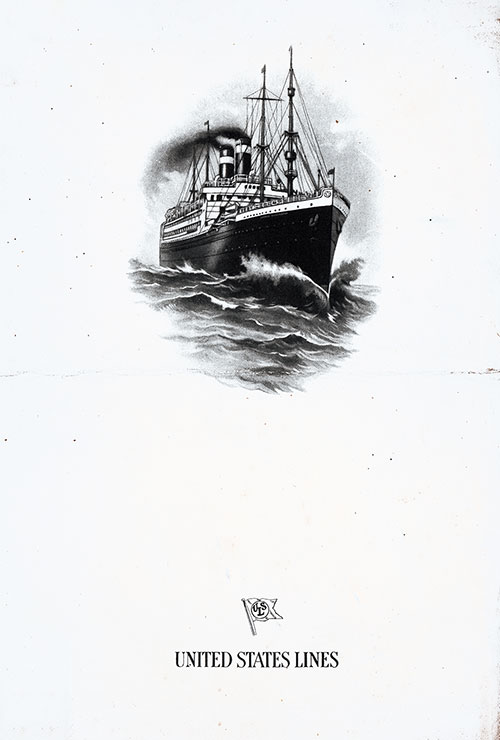
A Culinary Voyage Across the Atlantic: SS President Arthur's Dinner Delights from October 24, 1923
The dinner menu from October 24, 1923, aboard the SS President Arthur offers a fascinating glimpse into the elegant and diverse culinary traditions of transatlantic ocean travel. With dishes steeped in European influence, this menu provides a perfect educational resource for culinary historians, genealogists, teachers, and students interested in the social and gastronomic culture of the early 20th century. The inclusion of both English and German language versions reflects the international passenger demographic of that era.
The SS President Arthur's dinner menu from October 24, 1923, presents a delightful mix of familiar comforts and international culinary intrigue. The standout entrees, Veal Cutlets à la Pojarski and Fricandelles aux Morilles, exemplify the ship's commitment to offering both sophistication and variety to its passengers. This menu, rich with historical, cultural, and culinary significance, serves as a window into the golden age of ocean liner travel.
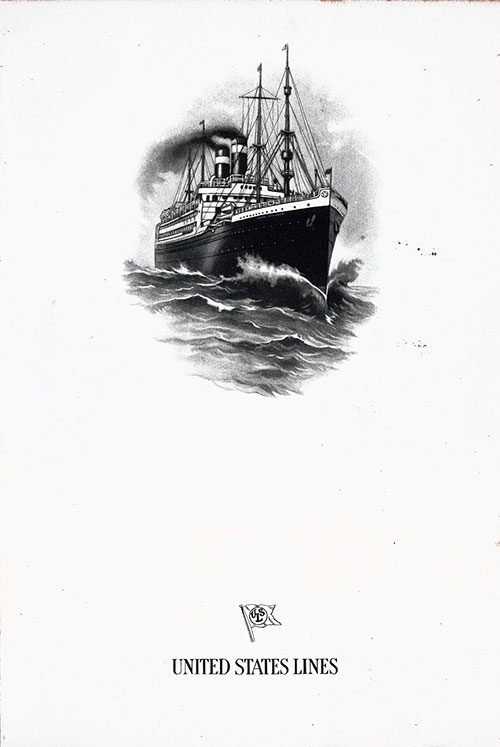
Gastronomic Adventures at Sea: A Review of the SS President Arthur Dinner Menu - October 25, 1923
The dinner menu from the SS President Arthur on October 25, 1923 offers a delightful glimpse into early 20th-century ocean travel dining. This carefully curated selection reflects both traditional American comfort foods and European culinary influences, appealing to a wide range of palates while introducing passengers to more exotic fare. The menu is bilingual, presented in both English and German, highlighting the international nature of the voyage.
The SS President Arthur's 1923 dinner menu reflects the luxurious yet diverse nature of ocean travel dining. Passengers were offered familiar favorites alongside new culinary experiences, blending American and European traditions to create an elegant and memorable dining event at sea.
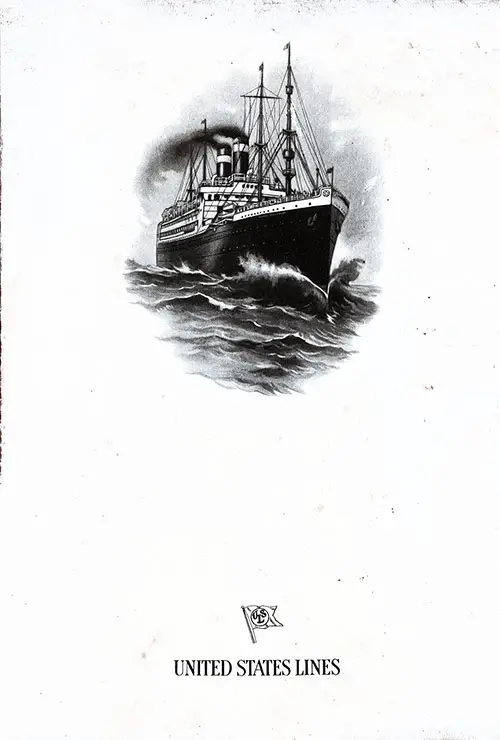
A Culinary Time Capsule: Exploring the SS President Arthur's Dinner Menu of 27 October 1923
The SS President Arthur's dinner menu from 27 October 1923 offers a delightful insight into early 20th-century transatlantic dining. Passengers aboard this United States Lines vessel were treated to a varied selection of dishes that combined traditional American fare with European culinary influences. This review highlights the selection and variety of the menu, the likely featured entrees, and items that may have perplexed the average American diner of the era.
The SS President Arthur's 1923 dinner menu reflects a transitional period in American dining, where comfort food met international flair. Passengers were encouraged to explore new flavors while enjoying familiar favorites. The inclusion of exotic terms, unusual entrees, and a well-rounded selection ensured a memorable dining experience for everyone on board.
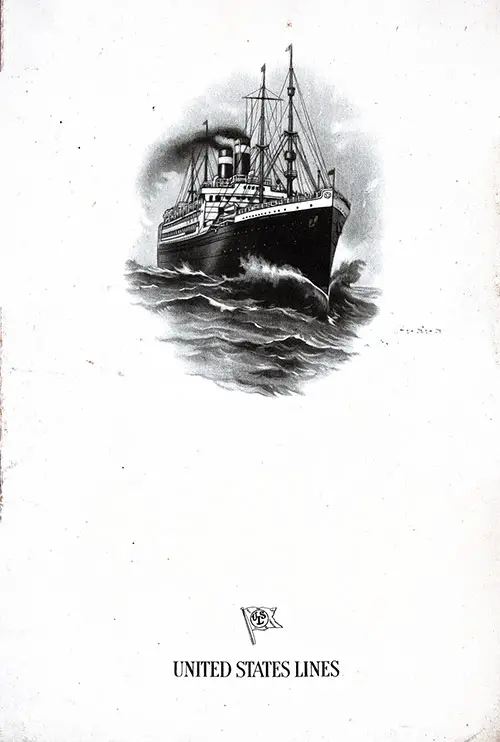
A Taste of Elegance at Sea: SS President Arthur's 28 October 1923 Dinner Menu
The SS President Arthur's dinner menu from October 28, 1923, presents an intriguing glimpse into early 20th-century ocean liner dining. The menu reveals an extensive selection of dishes, reflecting the culinary sophistication and international influences prevalent in ocean travel during that era. This review explores the menu's selection and variety, highlighting notable dishes and offering insight into potentially unfamiliar items.
The menu showcases a thoughtful balance of hors d’oeuvres, soups, fish, entrées, roasts, vegetables, salads, and desserts. The variety suggests an intent to cater to a broad range of palates while maintaining a luxurious dining experience.
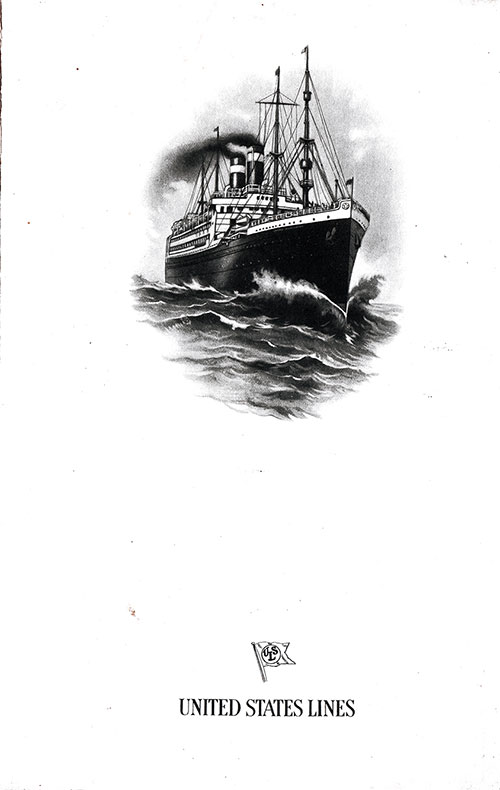
A Culinary Voyage Through Time: The SS President Arthur's Dinner Menu of 29 October 1923
On the evening of October 29, 1923, passengers aboard the SS President Arthur of the United States Lines were treated to a thoughtfully curated dinner menu. This menu was a blend of familiar favorites and European-inspired culinary delights, reflecting the cosmopolitan atmosphere of ocean travel during the early 20th century. The selections showcase both the elegance and adventurous spirit of the era, with dishes that would have intrigued and, perhaps, puzzled some American diners.
The SS President Arthur's menu represents an era when international travel offered not just a change of scenery but also a culinary adventure. Dishes like "Sweetbread Patties à la Toulouse" and "Omelette à la Romaine" reflect a time when shipboard dining aimed to replicate the experience of a high-end European restaurant.
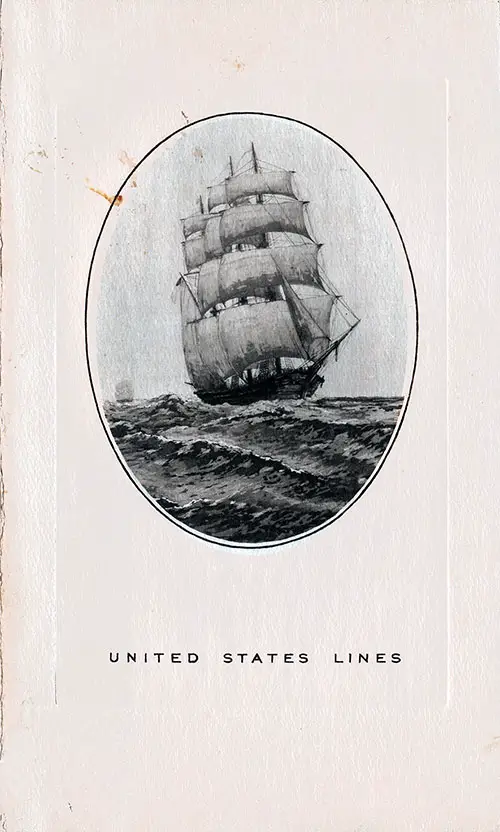
A Culinary Voyage: Exploring the SS Washington Dinner Menu of November 22, 1933
The SS Washington's dinner menu from November 22, 1933, presents a fascinating culinary journey, offering a delightful blend of timeless classics and unusual dishes that might have puzzled the typical American diner of the era. This elaborate tourist cabin menu features a well-curated selection of soups, hors d’oeuvres, entrées, roasts, seafood, and desserts, showcasing the variety and creativity of ocean liner cuisine during the early 20th century.
The menu reveals the culinary creativity of transatlantic travel during the early 20th century. The blend of familiar and exotic flavors, combined with high-quality ingredients and brand-name staples, reflected the ship's dedication to providing a memorable dining experience. Passengers undoubtedly savored their meals while anticipating the journey ahead, surrounded by the elegance and adventure that characterized ocean travel of the time.
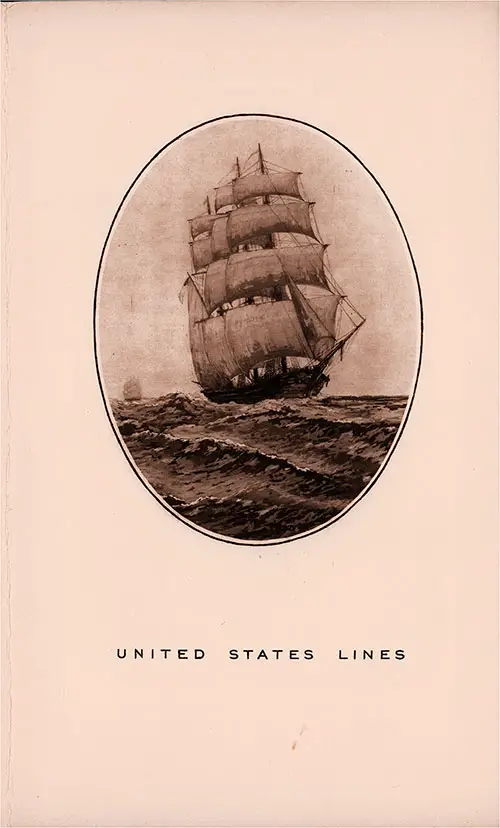
A Taste of Transatlantic Elegance: SS Washington Dinner Menu of November 24, 1933
The SS Washington's Tourist Cabin Dinner Menu from November 24, 1933, offers a fascinating glimpse into the dining culture aboard a transatlantic ocean liner during the early 20th century. This menu reflects a rich variety of dishes with a blend of European influences, American staples, and luxurious ingredients that would have delighted passengers. The menu presents a selection of seafood, meats, vegetables, and desserts that illustrate both traditional culinary practices and the exotic appeal of international cuisine.
This menu offers insights into the preferences and culinary standards of passengers aboard the SS Washington in 1933. The focus on European dishes, coupled with American classics like Prime Ribs of Beef au Jus, reflects the cultural interchange taking place during transatlantic voyages.
Historians might note the prominence of seafood, reflecting the ship's access to fresh fish in port cities. Genealogists can appreciate the detailed structure of the meal, possibly matching stories passed down through family generations about elegant shipboard dinners.
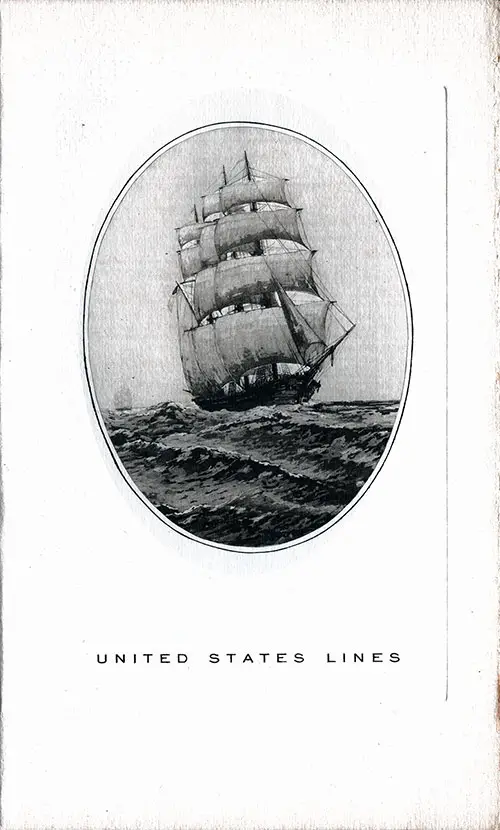
A Taste of Elegance at Sea: SS Washington Dinner Menu – November 25, 1933
The dinner menu for the SS Washington on November 25, 1933, provides a fascinating window into the culinary sophistication of transatlantic ocean travel during the early 20th century. Passengers traveling in Tourist Cabin class were treated to an impressive selection of dishes, showcasing international flavors, classic American fare, and creative culinary artistry. The meal reflects the ship’s dedication to high-quality dining experiences, even outside the more opulent first-class accommodations.
This meal, served aboard a luxurious ocean liner crossing the Atlantic, was not simply about sustenance—it was an experience designed to delight and entertain. The variety of foods, from the rich meats and delicate fish to the array of salads, breads, and desserts, would have made the dinner a memorable highlight of the voyage.
The inclusion of multiple sauces—Sauce Américaine, Sauce Lyonnaise, and Mugworth Gravy—reflects the influence of French culinary traditions on shipboard cuisine. Passengers with an adventurous palate would have relished trying the "Oyster Plants" or the "Paupiette of Sole," while those preferring familiar tastes could enjoy roast beef, ham, or turkey.
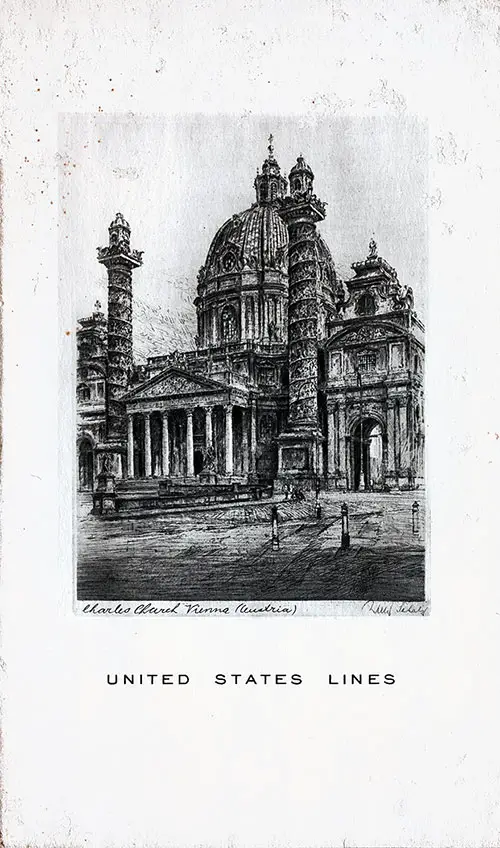
Dining in Style: A Culinary Tour Aboard the SS Manhattan – July 24, 1934
Dining aboard the SS Manhattan on July 24, 1934, was a culinary experience that combined international flair with familiar comforts. This Second Cabin dinner menu reflects the luxurious standards of ocean liner travel during the early 20th century. With its wide variety of dishes, from French classics to American staples, the menu was designed to please both adventurous diners and those seeking familiar flavors. The evening’s meal was further enhanced by a thoughtfully curated musical program, ensuring passengers enjoyed a delightful multisensory experience.
The SS Manhattan’s menu reveals more than just food—it reflects the era's luxurious, cosmopolitan ethos of ocean liner travel. Passengers, whether seasoned travelers or first-time voyagers, experienced a sense of adventure through the diverse flavors and culinary traditions served onboard. The attention to detail, from the creative entrée options to the live music program, underscored the liner's commitment to turning a meal into an event.
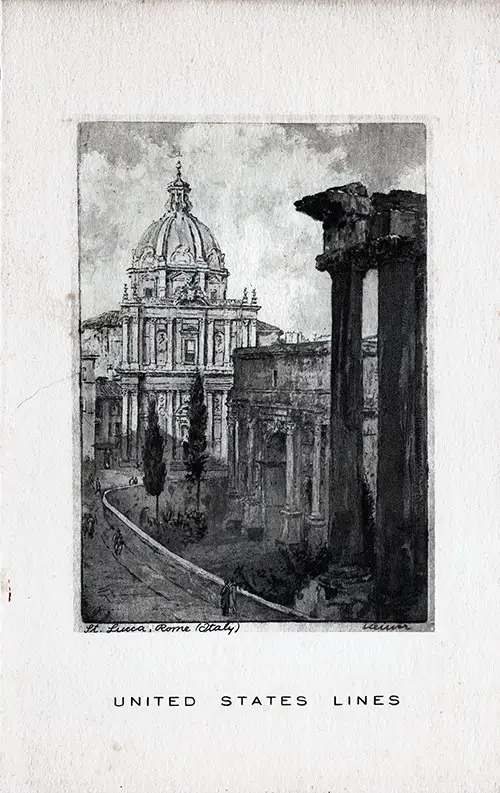
A Taste of Elegance: The SS Manhattan Dinner Menu – April 12, 1935
The SS Manhattan’s dinner menu from April 12, 1935, captures the elegance and international culinary flair of ocean travel during the interwar years. Passengers dining in the second cabin were treated to a sophisticated and diverse selection of dishes, ranging from traditional American favorites to continental delicacies. The evening was accompanied by a delightful live music program, enhancing the overall dining experience.
This elaborate menu not only showcases the ship's commitment to fine dining but also reflects the broader cultural and gastronomic trends of the 1930s, including the influence of European cuisine, the presence of well-known food brands, and the enduring appeal of classic comfort foods.
This dinner menu aboard the SS Manhattan exemplifies the luxurious, international nature of transatlantic travel in the 1930s. Passengers were not simply fed—they were treated to a culinary adventure that blended comfort foods with exotic selections from across the globe. The inclusion of detailed musical programs, well-known brands, and carefully crafted dishes underscored the ship’s commitment to providing an unforgettable dining experience.
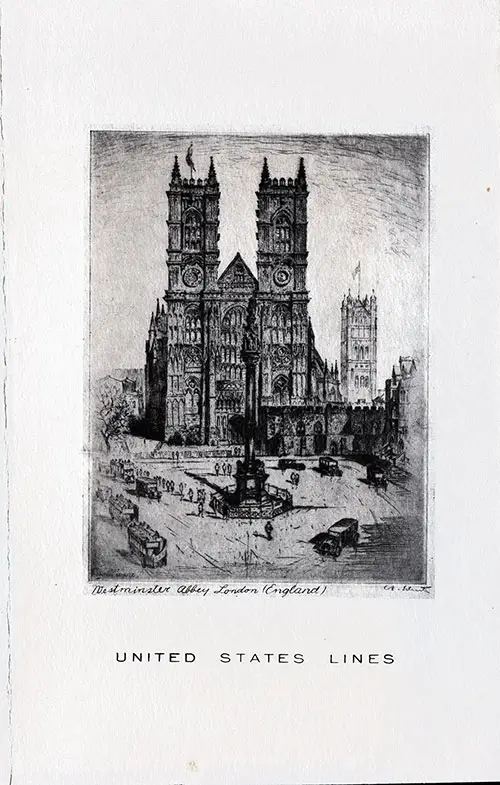
A Culinary Journey Across the Atlantic: The SS Manhattan Dinner Menu – April 13, 1935
The SS Manhattan dinner menu from April 13, 1935 reveals a fascinating glimpse into the sophisticated dining culture of transatlantic ocean travel during the 1930s. Passengers aboard this elegant United States Lines vessel were treated to an expansive and international menu featuring classic French, British, and American dishes, along with a few surprises from lesser-known European cuisines.
From exotic entrées like Lobster à la Newburg with Chester Straws to more familiar comforts like Prime Rib of Beef au Jus, the menu showcases the luxury and variety available at sea during this golden age of ocean liners. The meal was further enriched by a live musical program, completing the immersive, high-class experience for passengers.

Dining in Style: A Private Dinner Party on the SS Leviathan – June 10, 1928
Dining aboard the SS Leviathan, the flagship of the United States Lines, was always a refined affair—but a private dinner party was an elevated experience of its own. On June 10, 1928, Mr. S. B. Applebaum hosted such a gathering, bringing together distinguished guests for a meal that combined classic European culinary traditions with American comfort food, all served with meticulous attention to detail. The evening’s menu, presentation, and guest list reflect the social and gastronomic sophistication of the Golden Age of Ocean Travel.
This private dinner aboard the SS Leviathan was more than just a meal; it was a social statement. The host's selection of dishes balanced European refinement with American tradition, while the guest list hinted at the transatlantic connections common during the interwar years. Such meals were an integral part of ocean liner culture, bringing people together over fine food, lively conversation, and the shared excitement of international travel.
For those fortunate enough to attend, the evening was undoubtedly a highlight of their voyage across the Atlantic.
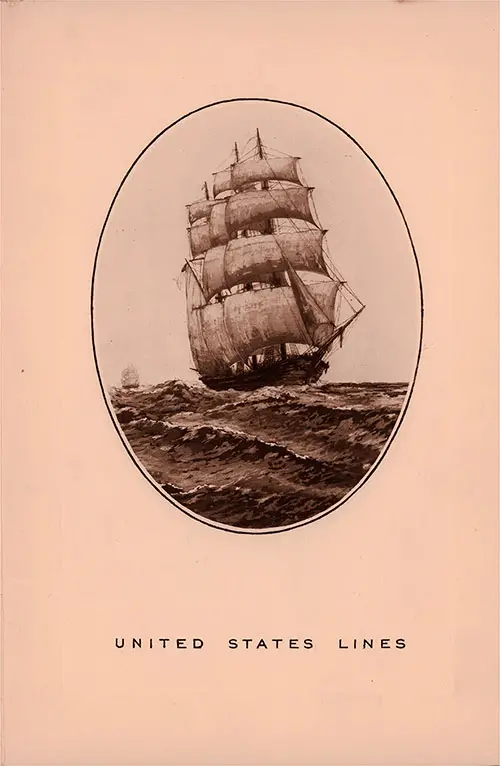
Masonic Masters and Wardens Dinner Dance: A Private Dining Affair Aboard the SS Washington – 1933
On the evening of December 13, 1933, the Fifth Masonic District of Manhattan gathered aboard the luxurious SS Washington of the United States Lines for a private dinner and dance. This elegant affair was not only a celebration of fellowship but also a testament to the culinary artistry and refined social experiences characteristic of ocean liner travel during the Golden Age of Transatlantic Voyages.
The menu offered that evening was rich in tradition, diverse in selection, and surprisingly cosmopolitan for an American liner of the time. From the Filet Mignon à l'Alsatienne to the Bluefish au Four, Cardinale, each course revealed the ship’s dedication to high-quality ingredients and culinary creativity.
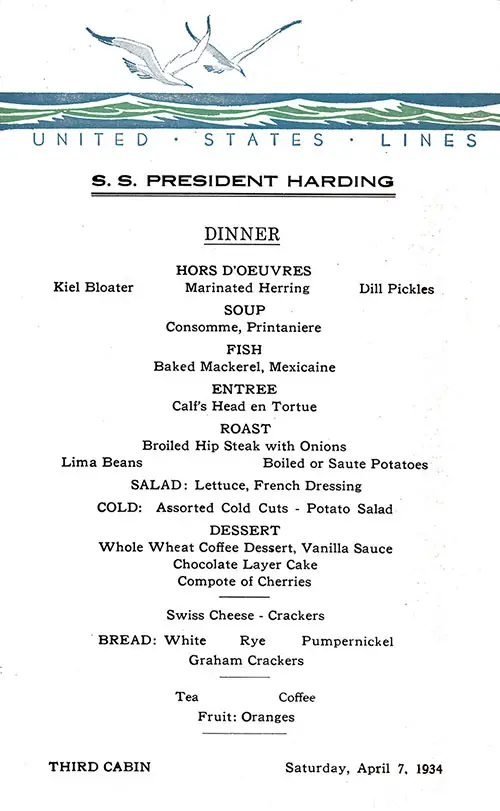
Calf's Head en Tortue and Chocolate Cake: SS President Harding Dinner Menu, April 7, 1934
On Saturday, April 7, 1934, passengers aboard the SS President Harding of the United States Lines enjoyed an evening meal that blended traditional American fare with continental European influences. The menu reflected the ship's Tourist Cabin dining style, offering hearty, familiar dishes with subtle culinary surprises. From the Calf's Head en Tortue to the Baked Mackerel, Mexicaine, the selection showcased the eclectic nature of transatlantic dining in the early 1930s.
The SS President Harding, part of the United States Lines, catered primarily to middle-class passengers seeking affordable, reliable transatlantic travel. Menus like this reflected practicality over opulence—though the chefs still infused variety to elevate the experience.
The SS President Harding’s April 7, 1934 menu offers a snapshot of culinary life at sea during the 1930s. The meal was simple yet diverse, balancing familiar favorites like hip steak with unusual delicacies like calf’s head stew. Brand-name staples like Graham crackers and the then-popular Kiel Bloater added familiarity to a menu filled with surprises.
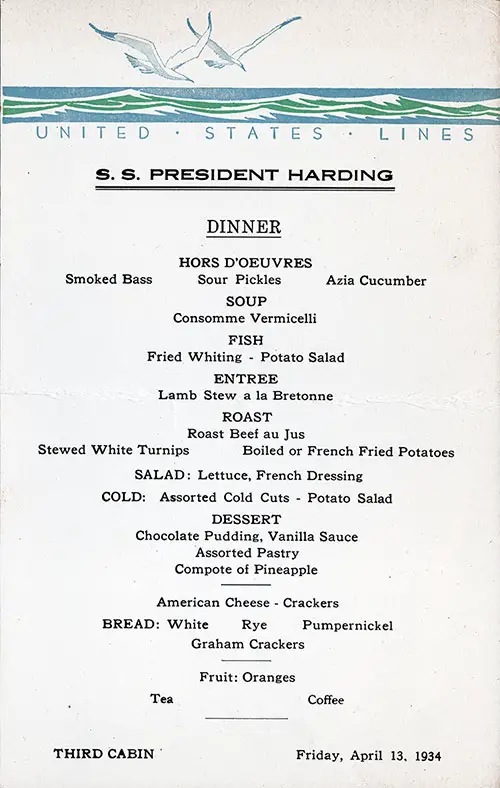
From Lamb Stew à la Bretonne to Chocolate Pudding: SS President Harding Dinner Menu – April 13, 1934
On Friday, April 13, 1934, passengers traveling in Third Cabin aboard the SS President Harding of the United States Lines were treated to a hearty, comforting dinner reflective of the culinary trends of the 1930s. The menu struck a balance between simplicity and variety, offering recognizable dishes with occasional European influences.
The SS President Harding’s dinner on April 13, 1934 demonstrates how third-cabin dining aboard a transatlantic liner could balance simplicity with variety. From the Breton-style lamb stew to the chocolate pudding dessert, the menu offers a taste of culinary life at sea during a period of economic hardship.
While simple staples like roast beef and fried fish dominated the 1934 transatlantic dining experience, the occasional nod to European cuisine — such as the Lamb Stew à la Bretonne — provided passengers with a hint of international adventure.
::::: USL Luncheon Menus :::::
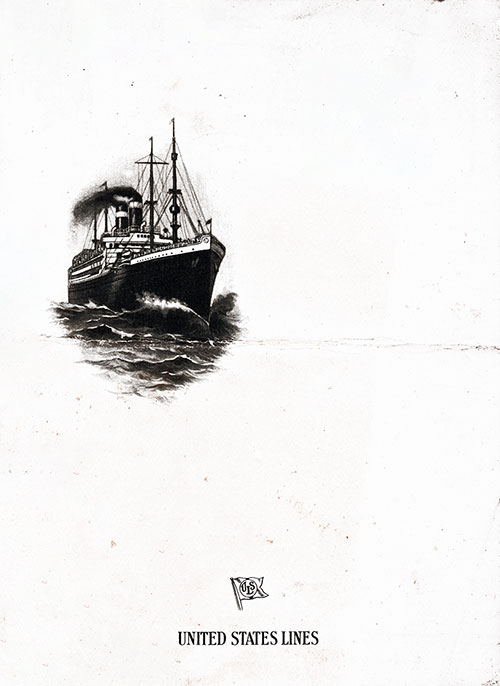
A Taste of the Atlantic: SS President Arthur's Luncheon Menu, October 23, 1923
The SS President Arthur’s luncheon menu from October 23, 1923, presents a robust, European-influenced selection of dishes, blending American comfort foods with German and French culinary traditions. As a vessel operated by the United States Lines, the President Arthur catered to a diverse group of travelers, including American tourists, immigrants, and European elites returning home.
Luncheons at sea were lighter than dinner but still hearty, with a balance of hot entrées, cold buffets, and classic desserts. This menu highlights both comfort and sophistication, offering rich sauces, grilled meats, and an array of seafood.
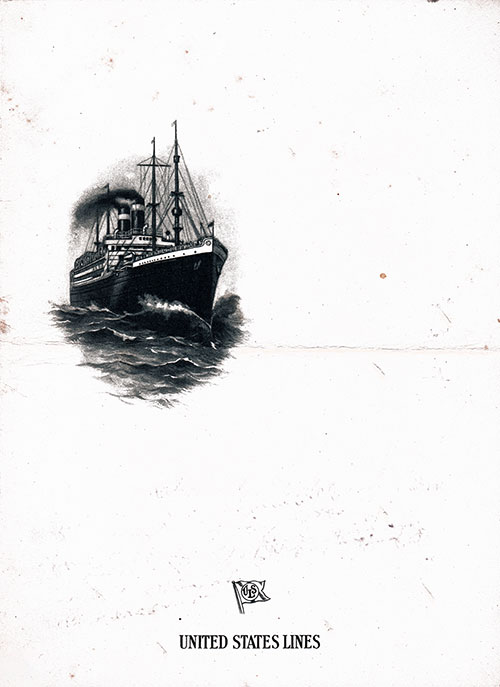
Hearty at Sea: SS President Arthur's Luncheon Menu, October 24, 1923
The SS President Arthur’s luncheon menu from October 24, 1923, offers a blend of hearty European-inspired dishes and American favorites, showcasing the rich culinary diversity of transatlantic travel. This menu, designed for passengers in the third-cabin class, reflects both affordability and variety, ensuring that travelers enjoyed a satisfying meal despite their class of passage.
The selection is robust and well-balanced, featuring classic hors d'oeuvres, fresh seafood, grilled meats, and rich desserts, making this a noteworthy representation of early 20th-century ocean liner dining.
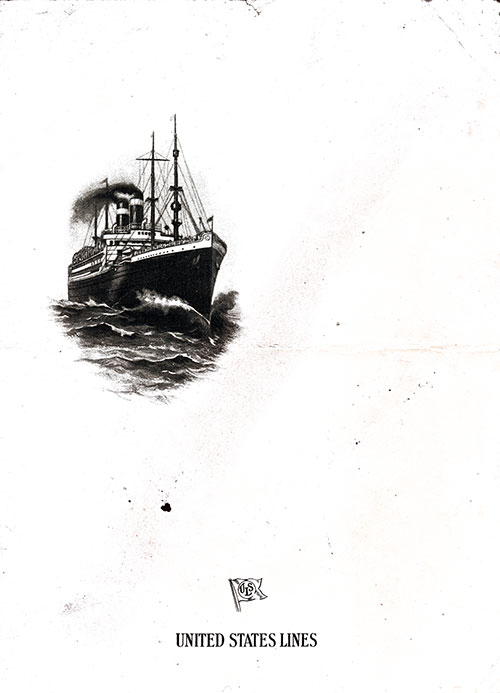
Third-Class Dining at Sea: SS President Arthur’s Luncheon Menu – October 25, 1923
The SS President Arthur’s luncheon menu from October 25, 1923, provides a rich selection of dishes, catering to a diverse range of passengers aboard this United States Lines transatlantic voyage. The menu balances European influences with American classics, offering everything from German-inspired sausages to French omelets and hearty American comfort food.
This third-class luncheon menu demonstrates the variety and quality of meals served at sea, highlighting a blend of hearty proteins, fresh vegetables, and indulgent desserts. Even passengers traveling in lower-class accommodations had access to fresh seafood, grilled meats, and a selection of cheeses and pastries, making ocean travel a culinary experience in its own right.
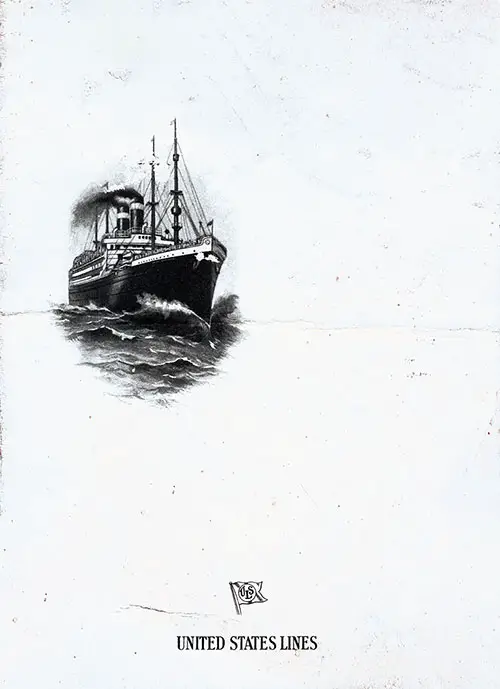
Dining at Sea: SS President Arthur’s 27 October 1923 Luncheon Menu – A Taste of Transatlantic Travel
The SS President Arthur’s luncheon menu from October 27, 1923, offers a compelling look into third-class dining aboard a transatlantic ocean liner. Despite being a midday meal for economy-class passengers, the menu boasts an impressive variety, with a mix of hearty American classics and European-inspired dishes.
The meal selection is a blend of comforting, familiar flavors and more adventurous offerings, catering to both American and European palates. While dishes like Sirloin Steak and Blackberry Pie would have been immediately recognizable to American travelers, selections such as Omelette aux Écrevisses (Crayfish Omelet) and Mackerel Dieppoise may have been less familiar.
This dining experience at sea represents a time when even third-class passengers could expect well-prepared, multi-course meals, setting transatlantic ocean travel apart from modern commercial air travel.
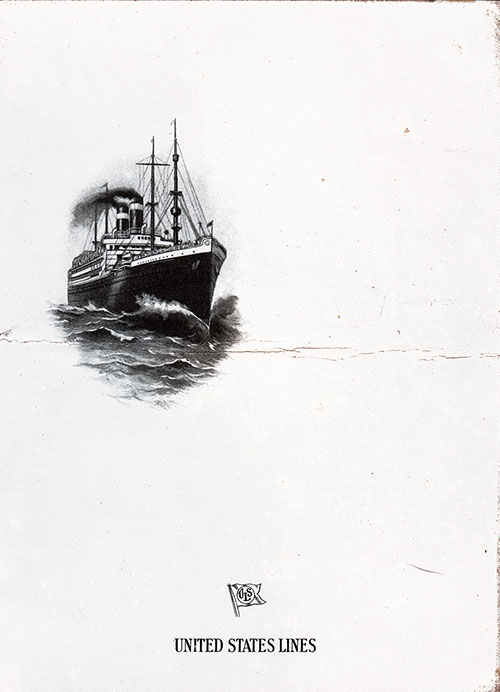
The SS President Arthur’s luncheon menu from October 28, 1923, presents a diverse selection of dishes, blending European culinary traditions with American tastes. Aboard this transatlantic liner, passengers in third class still enjoyed a full multi-course meal, demonstrating the high standards of shipboard dining in the early 20th century.
This menu is notable for its French and German-inspired dishes, catering to a mixed passenger demographic, likely including European immigrants and American travelers. The variety suggests an elevated dining experience despite being a midday meal in an economy-class setting.
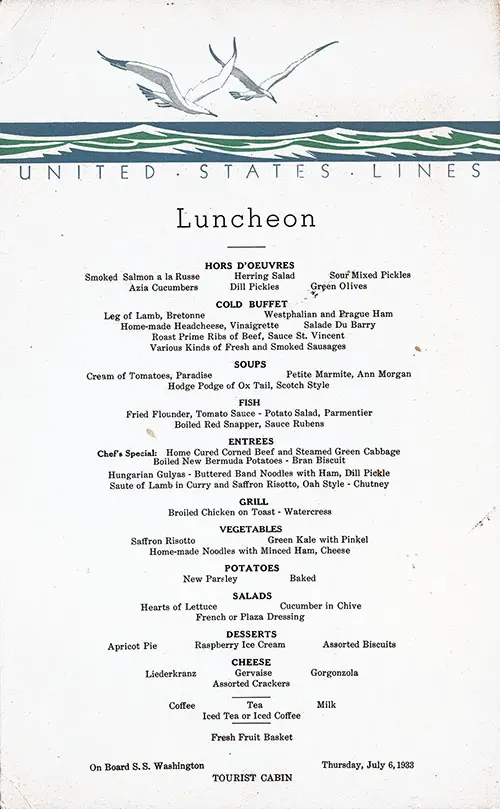
SS Washington Luncheon Menu (July 6, 1933): A Taste of Depression-Era Luxury at Sea
The SS Washington’s luncheon menu from July 6, 1933, is a remarkable example of Depression-era luxury travel, showcasing a lavish spread of European-inspired dishes alongside traditional American fare. Despite the economic difficulties on land, passengers aboard this United States Lines vessel enjoyed a broad selection of meats, seafood, and rich desserts in the Tourist Cabin class—demonstrating that even in difficult times, the grandeur of ocean travel remained intact.
This menu incorporates a mix of American, French, German, and Eastern European culinary influences, catering to a diverse passenger list of both American and European travelers.
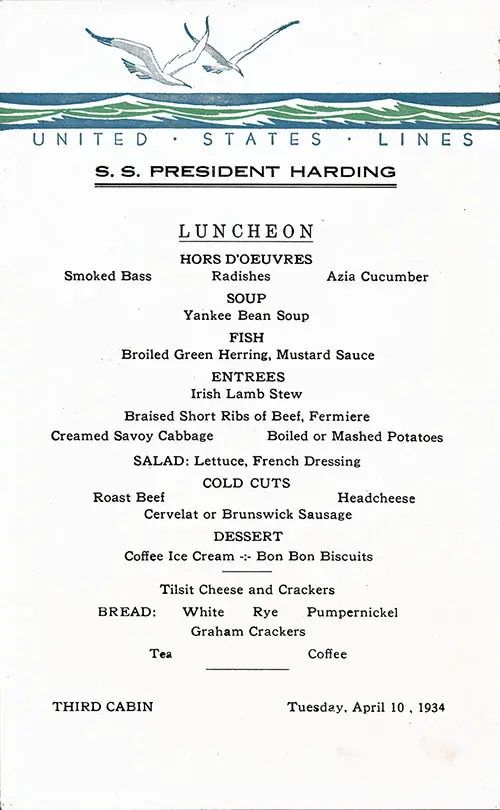
SS President Harding Luncheon Menu (April 10, 1934): A Third-Class Transatlantic Feast
The SS President Harding’s luncheon menu from April 10, 1934, offers a fascinating look into third-cabin dining aboard a transatlantic liner during the Great Depression. Despite being third-class fare, the menu boasts a well-balanced selection of hearty meats, seafood, salads, and desserts, demonstrating the high standards of shipboard catering at the time.
Passengers on this voyage were treated to classic American comfort foods alongside European-inspired dishes, catering to the diverse mix of travelers, including immigrants, tourists, and businessmen crossing the Atlantic.
Additionally, this menu’s reverse side contained handwritten passenger notes, adding a personal touch and providing insight into the voyage conditions, weather, and life at sea.
::::: USL Breakfast Menus :::::
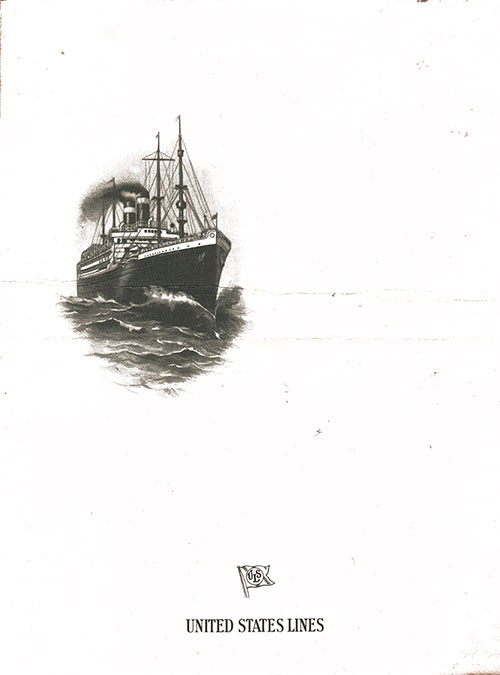
SS President Arthur Breakfast Menu (October 23, 1923): A Transatlantic Morning Feast
The SS President Arthur’s breakfast menu from October 23, 1923, offers a fascinating glimpse into the morning dining experience aboard an early 20th-century transatlantic liner. This menu is notable for its hearty American and European-inspired selections, with a broad array of cereals, eggs, meats, and fish options, reflecting the diverse backgrounds of passengers aboard.
Despite being set in the 1920s, the offerings would feel familiar to many modern diners, but several items—such as Force Cereal, Post Bran Flakes, and broiled kippered herring—provide an interesting look at how breakfast traditions have evolved.
Adding to the atmosphere of refined travel, passengers were treated to a morning concert on the promenade deck, featuring a mix of marches, waltzes, and contemporary foxtrots, making breakfast a truly cultured event at sea.
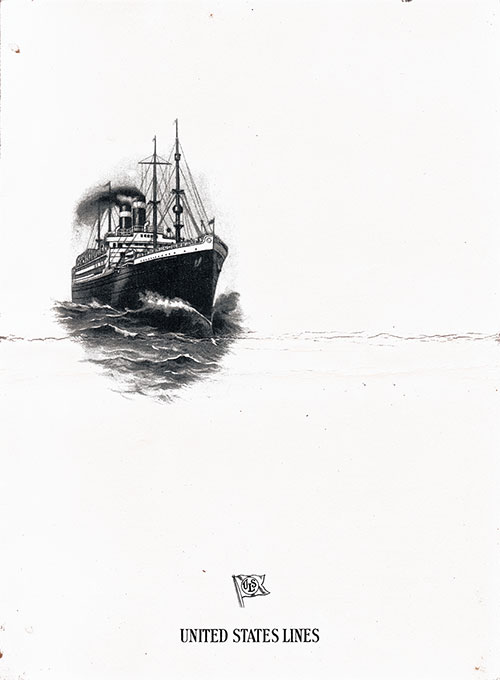
SS President Arthur Breakfast Menu (October 24, 1923): A Luxurious Start to the Day at Sea
The SS President Arthur’s breakfast menu from October 24, 1923, is a captivating snapshot of early 20th-century transatlantic dining, showcasing a blend of classic American breakfasts, refined European influences, and rare culinary selections that would have delighted travelers aboard this ocean liner.
Passengers had an extensive selection of cereals, eggs, meats, fish, and baked goods, demonstrating the lavish variety expected on a top-tier voyage. A notable feature of this breakfast service is its high level of sophistication, with menu items named after famous individuals (such as Omelette Sarah Bernhardt and Poached Eggs Rothschild), reinforcing the sense of luxury and prestige associated with ocean travel at the time.
1923-10-25 SS President Arthur Breakfast Menu
Vintage Breakfast Bill of Fare from Thursday, 25 October 1923 featured an extensive selection including Fried Eel in Drawn Butter, Scrambled Eggs à la Kleber, and Goulas à la Minute. The Bill of Fare selections were printed in English and German.
1923-10-26 SS President Arthur Breakfast Menu
Vintage Breakfast Bill of Fare from 26 October 1923 featured fruits, Cereals, Fish, Eggs & Pancakes, Meats, Mutton Chops, Potatoes and Toast.
1923-10-27 SS President Arthur Breakfast Menu and Concert Program
Vintage Breakfast Bill of Fare and Concert Program from 27 October 1923 offered Salted Cod and Fried Sole along with Stewed Apples for the Day's addition to standard American breakfast fare.
1923-10-28 SS President Arthur Breakfast Menu
Sunday's Breakfast Bill of Fare from 28 October 1923 featured Fried Codfish Steak, Fried Flounder, Rossini Eggs à la Turbigo and Diamond Stew in addition to traditional American fare.
1923-11-01 SS President Arthur Breakfast Menu
Vintage Breakfast Bill of Fare from Thursday, 1 November 1923 onboard the SS President Arthur featured Omelette à la Jurassienne, Shirred Eggs Meyerbeer, and Fricandelles, Onion Sauce in addition to tradational American fare.
1934-04-08 SS President Harding Breakfast Menu Card
Colorful breakfast Bill of Fare card from the SS President Harding offered a Third Cabin viewpoint through the passenger's diary of the day written on the back of the menu.
1934-04-13 SS President Harding Breakfast Menu Card
Vintage Third Cabin Breakfast Bill of Fare Card from 13 April 1934 featured Salt Mackerel, Clear Butter, Scrambled Eggs with Bacon or Plain, and Fried Country Sausage.
5. Books and Publications: In-depth Insights into USL Operations
The collection includes multi-volume works, historical essays, and pictorial guides that provide detailed accounts of USL's history.
Key Publications:
- 1972-1982: Leviathan: The World's Greatest Ship – Six volumes detailing the life of the famed ocean liner.
- 2003: Picture History of the SS United States – A comprehensive pictorial history.
- 1921: The George Washington – America's Largest Passenger Liner – Descriptive article on the SS George Washington.
Why It Matters: These texts serve as primary sources for maritime researchers and enthusiasts.
1972 - Leviathan: "The World's Greatest Ship" Volume 1
In September 1911, workers in the shipyard of Blohm & Voss in Hamburg started on a new ship that would be christened VATERLAND. The world would come to know her best as the LEVIATHAN, one of the grandest and most storied ocean liners of all time.
1974 - Leviathan: "The World's Greatest Ship" Volume 2
United States Lines: "LEVIATHAN: The World's Greatest Ship, Volume 2", by Frank Braynard, published in 1974, hardbound with original dust jacket, 380 pages. Braynard has created what is probably the most extensive history ever writte54n about a single ship.
1976- Leviathan: "The World's Greatest Ship" Volume 3
This book is volume 3 and picks up the LEVIATHAN saga as the ship begins transatlantic service for the United States Lines in 1923 and continues through 1926. Braynard tells the story of life aboard, prominent passengers, and her problems as a government owned ship. There are hundreds of great photos which makes for wonderful browsing and reading.
1978 - Leviathan: "The World's Greatest Ship" Volume 4
This book is volume 4 and picks up the LEVIATHAN saga in 1926 during the height of the ship's popularity and ends with the stock market crash in 1929. The ship's fortunes fell quickly after that. There are hundreds of great photos, including a section of color ones, which makes for wonderful browsing and reading.
1981 - Leviathan: "The World's Greatest Ship" Volume 5
This book is volume 5 and picks up the LEVIATHAN saga as the Great Depression starts and deeply cuts into passenger loads. The great ship produces nothing but red ink for USL and even bargain cruises do not help. The ship is put into lay-up and offered for sale. There are hundreds of great photos which makes for wonderful browsing and reading.
1982 - Leviathan: "The World's Greatest Ship" Volume 6
This book is the final volume and picks up the LEVIATHAN saga in her final years of lay-up in Hoboken. She sailed a few voyages in 1934 but otherwise spent her final years rusting at the pier. In 1938 her old boilers were fired one last time for a slow journey to the breakers. Many large photos of her abandoned interiors, as well as a fold-out color Albert Brenet painting of the ship approaching the breakers. There are hundreds of great photos which makes for wonderful browsing and reading.
2003 - Picture History of the SS United States
An international authority on ocean liners and the author of more than 45 books on the subject, William Miller has had a lifelong love affair with these magnificent ships--including the SS United States. Like many of this ship's loyal following, Miller was awed by its size, beautiful lines, aura of glamour, and speed. (Its maiden voyage in 1952 was a record-breaking one.) All these elements are captured in a book that pays tribute to this symbol of brilliant maritime technology.
The George Washington - America’s Largest Passenger Liner (1921)
The George Washington, distinguished by war service and peace missions, now taken over by the U. S. Mail Steamship Company (United States Lines)
6. Miscellaneous Ephemera: Everyday Life at Sea
Beyond the structured documents, the collection features a variety of items that reflect daily life aboard USL ships.
Examples:
- Personalized stationery from the SS Leviathan.
- Event programs for charitable musical concerts.
- Historical records detailing the Big Five ships of the U.S. Shipping Board.
Why It Matters: These artifacts offer a tangible connection to passengers' experiences, from casual letters to elegant social gatherings.
Letterhead Stationery, SS Leviathan
Letterhead correspondence stationery with matching envelope for the most famous ship SS Leviathan of the United States Lines.
::::: USL Concerts and Other Programs :::::
1922-07-20 Musical Concert Program - SS President Monroe
Early United States Lines Musical Program to raise funds for various seamen's charities, on board the SS President Monroe, performed for cabin class passengers in the Veranda Cafe on 20 July 1920.
1922-08-10 Musical Concert Program - SS President Monroe
Musical Concert Program to raise funds for various seamen's charitable organizations, held for cabin class passengers on 10 August 1922 in the Veranda Cafe onboard the SS President Monroe of the United States Lines.
1926-10-03 Musical Concert Program - SS Republic
Musical Concert Program held on the SS Republic of the United States Line on 3 October 1926 to benefit various seamen's charities and the Actors Fund of the United States. Talented passengers likely performed in the concert in addition to the Ship's Orchestra.
1928-06-21 Concert Program - SS Leviathan
Elegant Concert program and variety show for second class passengers on board the United States Lines Flagship -- the SS Leviathan. This production from Thursday, 21 June 1928 featured classical and popular music numbers, vocalists, readings, and a scene from a comedy playlet.
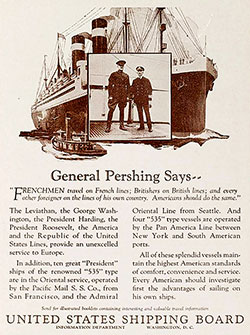
The Big Five of the Transatlantic Passenger Trade: Innovation, War, and the Race Across the Atlantic
The transatlantic passenger trade of the early 20th century represents a unique intersection of maritime innovation, geopolitics, and social evolution. The article, "The Big Five of the Transatlantic Passenger Trade," offers a compelling narrative on five key vessels—the Leviathan, George Washington, America, Agamemnon, and Mount Vernon. It explores how these seized German liners were transformed into American maritime assets following World War I.
